Africa
- Introduction
- Explosive ordnance risk education in Catabola, Angola: Safe practices make a village safer
- Angola
- Benin
- Burkina Faso
- Chad
- Democratic Republic of the Congo
- Guinea-Bissau
- Malawi
- Mauritania
- Mozambique
- Niger
- Senegal
- Somalia
- South Sudan
- Sudan
- Zimbabwe
- Regional Programs
- Other U.S. Support
- Back to Regions Menu
Introduction
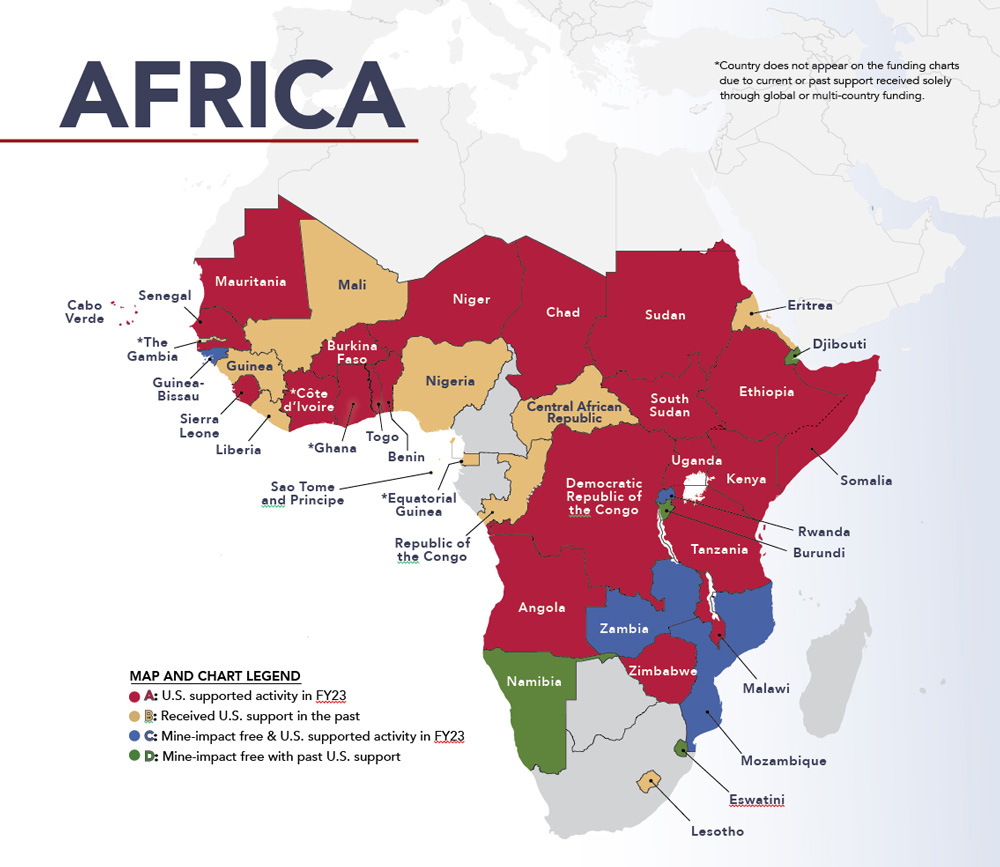
Across Africa, landmines and other explosive hazards from a wide range of conflicts impede economic development, post-conflict recovery, food security, and conservation. These explosive hazards, or even their suspected presence, can block access to infrastructure, basic services, and fertile farmland, and remain a dangerous reality for many civilians in Africa. Beyond explosive hazards, poorly secured government stockpiles of small arms, light weapons, and ammunition also threaten stability and human security across Africa. Illicit diversion of weapons and ammunition to destabilizing actors such as terrorists and transnational criminal organizations threaten the socio-economic fabric of civil society and fuel both local and regional conflicts. Substandard management of aging, unserviceable, and unstable ammunition can lead to catastrophic accidental explosions like the March 2021 blast in Bata, Equatorial Guinea. These explosions can result in mass casualties and long-term damage to critical infrastructure and the environment. When unplanned explosions occur in fragile democracies, they may also be politically destabilizing.
The United States works closely with its African partners to address these threats through a wide range of activities. U.S.-funded conventional weapons destruction programs survey and clear landmines and explosive remnants of war in high-priority areas and deliver lifesaving explosive ordnance risk education to vulnerable populations. U.S. demining efforts across Sub-Saharan Africa enable critical sustainable economic development, the security of civilians and livestock, and food security while promoting gender equality, climate resiliency, regional stability, and conservation priorities.
The United States also partners with countries across Africa to prevent the illicit diversion of small arms, light weapons, and ammunition to violent extremist groups, while increasing the operational effectiveness and accountability of host nation security forces. U.S. programs strengthen African partners’ capacity to secure and effectively manage their arms and ammunition inventories by marking weapons, building or refurbishing armories and depots, destroying unserviceable and unstable arms and ammunition, and training security forces to safely handle, manage, and store weapons and ammunition. Projects across Africa are helping partners strengthen accountability while denying destabilizing actors access to arms and ammunition.
FY23 cumulative performance metrics in Africa*
- 3,791,437 sq m (937 acres) of land cleared
- 15,079 landmines destroyed
- 99,309 risk education recipients
- 6,137 Explosive remnants of war destroyed
- 184.65 Metric tons of ammunition destroyed
*(Metrics include total U.S. assistance across the region, not just key metrics from featured countries)
Allocation of $28.84 million to Africa in FY23 by country (dollars in thousands)
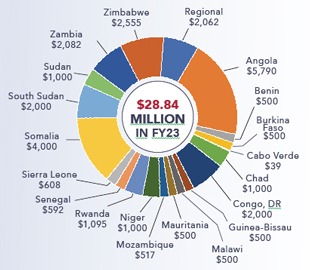
Top five countries funded in Africa FY93–FY23 (dollars in thousands)
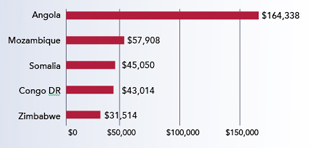
|
|
Country |
FY93-20 |
FY21 |
FY22 |
FY23 |
Total |
|
A |
Angola |
$145,731 |
$4,172 |
$8,645 |
$5,790 |
$164,338 |
|
A |
Benin |
$576 |
$500 |
$500 |
$500 |
$2,076 |
|
A |
Burkina Faso |
$3,941 |
$1,500 |
$1,500 |
$500 |
$7,441 |
|
D |
Burundi |
$3,371 |
$0 |
$0 |
$0 |
$3,371 |
|
A |
Cabo Verde |
$0 |
$0 |
$0 |
$39 |
39 |
|
B |
Central African Republic |
$1,009 |
$0 |
$0 |
$0 |
$1,009 |
|
A |
Chad |
$18,746 |
$1,000 |
$1,000 |
$1,000 |
$21,746 |
|
A |
Congo, DR |
$36,014 |
$3,000 |
$2,000 |
$2,000 |
$43,014 |
|
B |
Congo, Republic of the |
$2,839 |
$0 |
$0 |
$0 |
$2,839 |
|
D |
Djibouti |
$3,072 |
$0 |
$0 |
$0 |
$3,072 |
|
B |
Eritrea |
$18,118 |
$0 |
$0 |
$0 |
$18,118 |
|
D |
Eswatini |
$1,275 |
$0 |
$0 |
$0 |
$1,275 |
|
A |
Ethiopia1 |
$15,757 |
$0 |
$0 |
$0 |
$15,757 |
|
B |
Guinea |
$1,103 |
$0 |
$0 |
$0 |
$1,103 |
|
C |
Guinea-Bissau |
$9,981 |
$300 |
$0 |
$500 |
$10,781 |
|
A |
Kenya1 |
$3,037 |
$0 |
$0 |
$0 |
$3,037 |
|
B |
Lesotho |
$15 |
$0 |
$0 |
$0 |
$15 |
|
B |
Liberia |
$4,939 |
$0 |
$0 |
$0 |
$4,939 |
|
A |
Malawi |
$1,630 |
$1,300 |
$0 |
$500 |
$3,430 |
|
B |
Mali |
$5,412 |
$0 |
$0 |
$0 |
$5,412 |
|
A |
Mauritania |
$8,605 |
$500 |
$500 |
$500 |
$10,105 |
|
C |
Mozambique |
$56,391 |
$1,000 |
$0 |
$517 |
$57,908 |
|
D |
Namibia |
$9,515 |
$0 |
$0 |
$0 |
$9,515 |
|
A |
Niger |
$6,021 |
$1,000 |
$1,000 |
$1,000 |
$9,021 |
|
B |
Nigeria |
$2,140 |
$0 |
$0 |
$0 |
$2,140 |
|
C |
Rwanda |
$14,193 |
$1,000 |
$505 |
$1,095 |
$16,793 |
|
B |
Sao Tome and Principe |
$50 |
$0 |
$0 |
$0 |
$50 |
|
A |
Senegal |
$7,622 |
$1,488 |
$556 |
$592 |
$10,258 |
|
A |
Sierra Leone |
$1,740 |
$0 |
$39 |
$608 |
$2,387 |
|
A |
Somalia |
$33,050 |
$4,000 |
$4,000 |
$4,000 |
$45,050 |
|
A |
South Sudan2 |
$16,961 |
$2,000 |
$2,000 |
$2,000 |
$22,961 |
|
A |
Sudan2 |
$3,450 |
$1,000 |
$0 |
$1,000 |
$5,450 |
|
B |
Sudan and South Sudan2 |
$24,427 |
$0 |
$0 |
$0 |
$24,427 |
|
A |
Tanzania1 |
$2,636 |
$0 |
$0 |
$0 |
$2,636 |
|
A |
Togo1 |
$32 |
$0 |
$0 |
$0 |
$32 |
|
A |
Uganda1 |
$1,263 |
$0 |
$0 |
$0 |
$1,263 |
|
C |
Zambia1 |
$2,487 |
$0 |
$0 |
$2,082 |
$4,569 |
|
A |
Zimbabwe |
$24,021 |
$1,685 |
$3,253 |
$2,555 |
$31,514 |
|
|
Regional |
$19,149 |
$1,950 |
$2,000 |
$2,062 |
$25,161 |
|
|
Total |
$510,319 |
$27,395 |
$27,499 |
$28,840 |
$594,052 |
- Countries with activities in FY23 that occurred through Global/Multi-Country funding but received direct funding in the past.
- The “Sudan and South Sudan” budget line reflects the total funding for Sudan until 2011, when the country split into Sudan and South Sudan. The separate funding lines for “Sudan” and “South Sudan” reflect their respective separate funding totals since 2011.
CHART LEGEND
A: U.S. supported activity in FY23
B: Received U.S. support in the past
C: Mine-impact free & U.S. supported activity in FY23
D: Mine-impact free with past U.S. support
Explosive ordnance risk education in Catabola, Angola: Safe practices make a village safer
Article and images courtesy of The HALO Trust.
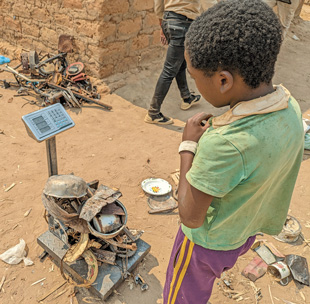
A young boy in São Lucas weighs scrap metal.
Three young boys are hanging around an adobe house in their village, São Lucas, Angola. Leaning against the house is a stack of metal items including discarded car parts, rusted gears, bowls, mugs, and a tangle of wires, all meant to be recycled. The boys collect and transfer the items to a recycling center in exchange for roughly 50 U.S. cents worth of Angolan currency. While 50 cents is considered spare change in the United States, in rural Angola, these small earnings are often an important part of family livelihoods. However, this source of income is dangerous. Decades of armed civil conflict left Angola littered with landmines and explosive remnants of war. Today, children and adults can mistake explosive remnants of war when looking for scrap metal to recycle.

Paula Samba, the soba or traditional leader for São Lucas, is the first woman soba for the community and one of the few female sobas across the country. She says, “Thirty years ago, the village of São Lucas did not exist. It was forest, and agricultural areas. Back then, the Angolan Civil War was still raging, and numerous battles occurred where the village now stands. It’s only about 8 miles from Uyue River, one of the major frontlines of the war.”
To minimize this danger, The HALO Trust delivers explosive ordnance risk education to rural communities in Angola such as São Lucas, so residents can better identify and avoid explosive hazards. These risk education efforts are one of several humanitarian mine action initiatives in Angola funded by the Department of State’s Office of Weapons Removal and Abatement in the Bureau of Political-Military Affairs.
After one of HALO’s risk education sessions in the area, the community identified a decades old cache of grenades and artillery shells. The cache was reported to the police, and the police coordinated with HALO to transfer the explosive hazards to a secure site for safe destruction.
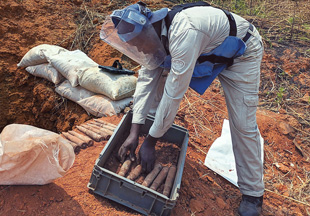
HALO personnel prepare an old cache of unserviceable ammunition for safe destruction.
“Clearance of the area began in 2003, and in 2008 people started to come back, build houses, and grow crops. The area began to grow,” says Paula. “Now numbering 2,707 residents, São Lucas’ main economic activity is agriculture. In the Catabola municipality, 90% of residents do agricultural work,” says Hernane Mateus, secretary to the local administrator of Catabola.
“Explosive ordnance risk education and stockpile destruction are good initiatives,” says Paula. “We know if bombs explode, it will kill many people. Many of our kids still don’t know [about the explosive ordnance problem] …if they find the items, they may play with them or collect them to recycle, and if something explodes it will kill them. With explosive ordnance risk education, we won’t face so many challenges with kids touching the items.”
Angola
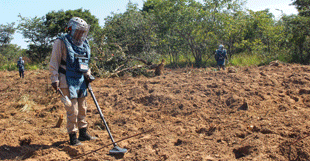
In Angola, deminers use metal detectors to search for explosive hazards in a field cleared of vegetation. Courtesy of The HALO Trust.
Angola made great strides in 2023 to recover from over 40 years of conflict that ended in 2002. In 2023, U.S. funded demining operations contributed significantly to the recovery by returning more than 2.3 million square meters (592 acres) of cleared land to local communities. While much land has been cleared of explosive hazards, Angola still has more than 68.01 million square meters (16,805 acres) of contaminated land remaining as of 2023 according to Angola’s National Mine Action Agency.
From FY94 to FY23, the United States invested more than $164 million for conventional weapons destruction in Angola. This assistance has returned more than 471 million square meters (116,837 acres) to productive use and destroyed 111,073 landmines and explosive remnants of war. Conventional weapons destruction assistance also destroyed 113,669 excess small arms and light weapons and 615 metric tons of unserviceable ammunition from government stockpiles, reducing the risk of explosions and illicit diversions.
In FY23, the Department of State supported:
Survey and clearance of high priority areas in Bié, Cuando Cubango, Humabo, and Moxico Provinces to bolster human security as well as facilitate economic and agricultural development. Survey and clearance operations in southern Moxico and Cuando Cubango Provinces directly support the Government of Angola’s environmental conservation efforts and eco-tourism development in the Okavango River basin.
Physical security and stockpile management engagements in Moxico, Lunda Sul, and Lunda Norte Provinces that strengthened security forces’ weapons management capacity through training and destroying unserviceable and unstable weapons and ammunition.
The capacity development of Angola’s National Mine Action Agency to better regulate, manage, and coordinate mine clearance activities throughout Angola’s 15 priority provinces, with minimal outside technical support.
With funding from the Department of Defense, the Humanitarian Demining Research and Development Program partnered with MAG (Mines Advisory Group) to evaluate the Rex, a versatile, light-weight armored excavator modified by the integration of demining attachments; and partnered with The HALO Trust to continue evaluation of the Handheld Standoff Mine Detection System (HSTAMIDS) and the Minelab GPZ-7000. With these technologies, approximately 2.1 million square meters (519 acres) of land, and over 1,500 mines and unexploded ordnance were cleared since 2006.
|
Source |
FY94–20 |
FY21 |
FY22 |
FY23 |
Total |
|
DOS NADR-CWD |
$124,604 |
$4,000 |
$8,500 |
$5,500 |
$142,604 |
|
DOS Other |
$3,170 |
$0 |
$0 |
$0 |
$3,170 |
|
CDC |
$150 |
$0 |
$0 |
$0 |
$150 |
|
DoD |
$9,456 |
$172 |
$145 |
$290 |
$10,063 |
|
USAID |
$8,351 |
$0 |
$0 |
$0 |
$8,351 |
|
Total |
$145,731 |
$4,172 |
$8,645 |
$5,790 |
$164,338 |
(Dollars in thousands)
FY23 Angola key performance metrics:
- 2,396,460 Sq m (592 acres) of land cleared
- 667 Explosive ordnance disposal call-outs
- 625 Landmines destroyed
- 3,479 Explosive remnants of war destroyed
- 1,224 Small arms and light weapons destroyed
- 71,983 Explosive ordnance risk education recipients
- 23 Personnel trained in stockpile management
- The HALO Trust, MAG (Mines Advisory Group), Norwegian People’s Aid
Benin
U.S. conventional weapons destruction assistance strengthens Benin’s national defense forces’ capacity to manage stockpiles of small arms, light weapons, ammunition, and explosives, and keeps them from falling into the hands of violent extremist organizations. From FY07 to FY23, the United States invested more than $2 million to destroy stockpiles of unserviceable and unstable weapons and ammunition, build secure storage facilities for weapons and ammunition, and train Beninese forces on weapons and ammunition management. This assistance helps Benin stand up to violent extremism, prevent unplanned explosions at munition sites, and prevent the illicit diversion of weapons that can lead to destabilization across the Coastal West Africa region.
In FY23, the Department of State supported:
- Destruction of unserviceable and unstable ammunition to reduce the likelihood of illicit diversion and unplanned explosions at storage sites, and training for members of the Benin Armed Forces in armory management and ammunition destruction.
|
Source |
FY07–20 |
FY21 |
FY22 |
FY23 |
Total |
|
DOS NADR-CWD |
$562 |
$500 |
$500 |
$500 |
$2,062 |
|
DoD |
$14 |
$0 |
$0 |
$0 |
$14 |
|
Total |
$576 |
$500 |
$500 |
$500 |
$2,076 |
(Dollars in thousands)
FY23 Benin key performance metrics:
- 104.33 Metric tons of unserviceable ammunition destroyed
- 60 Personnel trained in stockpile management
- MAG (Mines Advisory Group)
Burkina Faso
Burkina Faso continues to combat illicit diversion and trafficking of weapons and ammunition in the face of escalating violent extremist organization activity in the region. The United States has invested more than $7 million from FY15 to FY23 to improve Burkina Faso’s physical security and stockpile management practices, developing stronger accountability and management practices that better protect civilians from the many risks associated with poorly stored weapons and ammunition, including terrorism and proliferation of weapons into local communities and the broader region.
In FY23, the Department of State supported:
Marking weapons in gendarmerie, police, and military stockpiles with unique serial numbers to improve accountability.
- Construction of secure armories and ammunition storage facilities.
- Destruction of unserviceable and unstable ammunition, small arms, and light weapons.
- Physical security and stockpile management training for armory personnel.
|
Source |
FY15–20 |
FY21 |
FY22 |
FY23 |
TOTAL |
|
DOS NADR-CWD |
$3,941 |
$1,500 |
$1,500 |
$500 |
$7,441 |
|
Total |
$3,941 |
$1,500 |
$1,500 |
$500 |
$7,441 |
(Dollars in thousands)
FY23 Burkina Faso key performance metrics:
- 13 Personnel trained in stockpile management
- 9 Armories built or rehabilitated
- MAG (Mines Advisory Group)
Chad
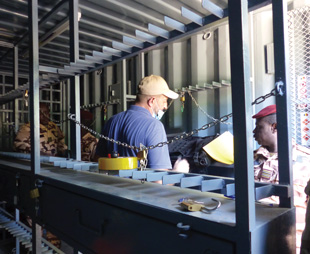
Physical security and stockpile management training is conducted in Chad. Courtesy of MAG (Mines Advisory Group).
Chad is a key transit point for illicit weapons flowing to and from Libya, and a destination point for weapons trafficked illicitly from Sudan into eastern Chad. With U.S. support, conventional weapons destruction programs help ensure Chadian Government arms and ammunition stockpiles remain secure and serviceable as the Chadian military continues to make substantial efforts to counter threats from violent extremists.
From FY98 to FY23, the United States invested more than $21 million in Chad to clear landmines, destroy unserviceable and unstable small arms and light weapons and ammunition, and improve physical security and stockpile management.
In FY23, the Department of State supported:
- Marking weapons in government stockpiles with unique serial numbers to improve stockpile accountability.
- Destruction of unserviceable and unstable ammunition, small arms, and light weapons.
- Training in stockpile management.
- Building and refurbishing of storage facilities for the military, gendarmerie, and national guard.
|
SOURCE |
FY98–20 |
FY21 |
FY22 |
FY23 |
TOTAL |
|
DOS NADR-CWD |
$13,556 |
$1,000 |
$1,000 |
$1,000 |
$16,556 |
|
DoD |
$5,190 |
$0 |
$0 |
$0 |
$5,190 |
|
Total |
$18,746 |
$1,000 |
$1,000 |
$1,000 |
$21,746 |
(Dollars in thousands)
FY23 Chad key performance metrics:
2.79 Metric tons of unserviceable ammunition destroyed
599 Small arms and light weapons destroyed
90 Small arms and light weapons marked
102 Personnel trained in stockpile management
9 Armories built or rehabilitated
MAG (Mines Advisory Group)
Democratic Republic of the Congo
The Democratic Republic of the Congo’s eastern provinces continue to suffer from intense fighting between non-state actors and government forces, fueled by the illicit proliferation of weapons and ammunition, resulting in further population displacement, contamination with explosive remnants of war, and suppressed economic development. Armed conflict has also left many provinces contaminated with explosive hazards that endanger civilians, block access to arable land, and worsen food insecurity. From FY02 to FY23, the United States invested more than $43 million in funding for conventional weapons destruction in the Democratic Republic of the Congo, destroying a total of 180,739 small arms and light weapons and 1,813 metric tons of ammunition, as well as upgrading armories and training security force personnel in physical security and stockpile management. Support for landmine survey and clearance returned 668,727 square meters (165 acres) of land to productive use and prevented injuries through explosive ordnance risk education provided to 158,003 individuals.
In FY23, the Department of State supported:
- Explosive ordnance risk education and demining operations in priority provinces including Kasai and Kasai Centrale.
|
Source |
FY02–20 |
FY21 |
FY22 |
FY23 |
TOTAL |
|
DOS NADR-CWD |
$27,334 |
$3,000 |
$2,000 |
$2,000 |
$34,334 |
|
DoD |
$1,083 |
$0 |
$0 |
$0 |
$1,083 |
|
USAID |
$7,597 |
$0 |
$0 |
$0 |
$7,597 |
|
Total |
$36,014 |
$3,000 |
$2,000 |
$2,000 |
$43,014 |
(Dollars in thousands)
FY23 Democratic Republic of the Congo key performance metrics:
- 6,558 Sq m (1.62 acres) of land cleared
- 42 Explosive ordnance disposal call-outs
- 44 Explosive remnants of war destroyed
- 16,784 Explosive ordnance risk education recipients
- DanChurchAid
Guinea-Bissau
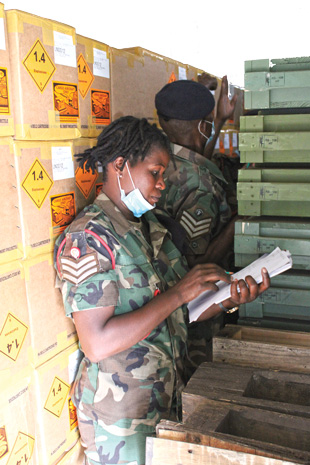
Physical security and stockpile management training takes place in Guinea-Bissau. Courtesy of The HALO Trust.
Aging munitions stockpiles and storage infrastructure pose safety and security challenges in Guinea-Bissau. U.S. conventional weapons destruction assistance has enabled Guinea-Bissau to secure its weapons and ammunition, destroy large stockpiles of unserviceable and unstable explosive munitions, and declare itself free from known anti-personnel landmine contamination in 2012.
From FY00 to FY23, the United States invested more than $10 million with a primary focus on physical security and stockpile management needs in recent years.
In FY23 Guinea-Bissau was included in the Coastal West Africa regional program detailed in the regional programs section. FY23 funds will support a standalone program in Guinea-Bissau that will help Guinea-Bissau destroy unserviceable and unstable ammunition, build secure armories and ammunition storage facilities, and strengthen security forces weapons and ammunition management capacity. This program, as well as support provided under the Coastal West Africa program, complement an earlier African Union-sponsored assessment of Guinea-Bissau stockpiles under its Ammunition Management Safety Initiative.
|
Source |
FY00–20 |
FY21 |
FY22 |
FY23 |
TOTAL |
|
DOS NADR-CWD |
$8,537 |
$300 |
$0 |
$500 |
$9,337 |
|
DoD |
$1,444 |
$0 |
$0 |
$0 |
$1,444 |
|
Total |
$9,981 |
$300 |
$0 |
$500 |
$10,781 |
(Dollars in thousands)
FY23 Guinea-Bissau Key performance metrics:
- Performance metrics related to Guinea-Bissau are included under the Coastal West Africa program.
- The HALO Trust
Malawi
Aging ammunition stockpiles and illicit small arms and light weapons diversion present challenges for Malawi’s security. Between 2019 and 2023, the United States upgraded physical infrastructure, destroyed unserviceable and unstable ammunition, and trained Malawian security forces to international standards for physical security and stockpile management to prevent diversion and depot explosions.
From FY18 to FY23, the United States invested more than $3 million in conventional weapons destruction efforts in Malawi.
In FY23 (with prior year funds), the Department of State supported:
- Armory and ammunition storehouse construction.
- Training of security forces in physical security and stockpile management standards.
|
Source |
FY18–20 |
FY21 |
FY22 |
FY23 |
TOTAL |
|
DOS NADR-CWD |
$1,630 |
$1,300 |
$0 |
$500 |
$3,430 |
|
Total |
$1,630 |
$1,300 |
$0 |
$500 |
$3,430 |
(Dollars in thousands)
FY23 Malawi key performance metrics:
- 93 Personnel trained in stockpile management
- 8 Armories built or rehabilitated
- The HALO Trust
Mauritania
Most of Mauritania is in the Sahara Desert, and its remote areas are often transit points for small arms and light weapons illicitly trafficked to and from the Sahel and Coastal West Africa. U.S. investments in conventional weapons destruction have helped Mauritanian security forces to secure their weapons and ammunition in facilities that meet international standards and effectively manage weapons to prevent diversion to violent extremists and arms traffickers. These efforts help maintain Mauritania’s stability and assist its security efforts in the Sahel. From FY99 to FY23, the United States invested more than $10 million in Mauritania. This funding supported the building and refurbishing of 13 storage facilities, destroyed 3,189.6 metric tons of ammunition and 375 MANPADS, and trained 54 personnel in stockpile management.
In FY23, the Department of State supported:
- A physical security and stockpile management project to greatly increase explosive storage capacity for serviceable ammunition.
- Destruction of unserviceable and unstable munitions.
|
Source |
FY99–20 |
FY21 |
FY22 |
FY23 |
TOTAL |
|
DOS NADR-CWD |
$4,195 |
$500 |
$500 |
$500 |
$5,695 |
|
DoD |
$4,410 |
$0 |
$0 |
$0 |
$4,410 |
|
Total |
$8,605 |
$500 |
$500 |
$500 |
$10,105 |
(Dollars in thousands)
FY23 Mauritania key performance metrics:
- 40.46 Metric tons of unserviceable ammunition destroyed
- MAG (Mines Advisory Group)
Mozambique
While Mozambique has declared itself landmine-free, violent extremism continues to threaten security and stability. The United States supported Mozambique’s humanitarian mine action efforts from 2005 until 2015 when Mozambique declared itself landmine-free. The United States and Mozambique resumed conventional weapons destruction cooperation in 2022 on a project to strengthen security forces’ capacity to manage weapons and ammunition and prevent illicit diversion.
In FY23, the Department of State supported:
- Construction and deployment of mobile armories for the Ministry of Defense.
- Training of Mozambican security forces to strengthen management capacity and prevent illicit diversion of small arms and light weapons.
With funding from the Department of Defense, U.S. Africa Command completed a holistic requirements determination site survey to research requirements and capability gaps in demining, explosive ordnance disposal, physical security and stockpile management, and emergency medical response.
|
Source |
FY93–20 |
FY21 |
FY22 |
FY23 |
TOTAL |
|
DOS NADR-CWD |
$34,782 |
$1,000 |
$0 |
$500 |
$36,282 |
|
DOS Other |
$1,600 |
$0 |
$0 |
$0 |
$1,600 |
|
CDC |
$2,100 |
$0 |
$0 |
$0 |
$2,100 |
|
DoD |
$13,376 |
$0 |
$0 |
$17 |
$13,393 |
|
USAID |
$4,533 |
$0 |
$0 |
$0 |
$4,533 |
|
Total |
$56,391 |
$1,000 |
$0 |
$517 |
$57,908 |
(Dollars in thousands)
FY23 Mozambique key performance metrics:
- 8 Armories built or rehabilitated
- The HALO Trust
Niger
Since 2015, the U.S. has provided support to reduce weapons proliferation into greater West Africa while simultaneously improving the capacity of Nigerien Security Forces to safely manage and store weapons and ammunition as well as destroy obsolete weapons and ammunition. In July 2023, a coup d’état resulted in the indefinite suspension of conventional weapons destruction programming.
From FY15 to FY23, the United States invested more than $9 million in conventional weapons destruction funding to build or rehabilitate 30 storage facilities, train personnel in physical security and stockpile management, destroy 15 metric tons of unserviceable ordnance, and mark 6,000 small arms and light weapons belonging to Nigerien security forces.
In FY23, and prior to the suspension of conventional weapons destruction assistance, the Department of State supported 11 technical assessments of small arms and light weapons storage facilities.
|
Source |
FY15–20 |
FY21 |
FY22 |
FY23 |
TOTAL |
|
DOS NADR-CWD |
$5,693 |
$1,000 |
$1,000 |
$1,000 |
$8,693 |
|
DoD |
$328 |
$0 |
$0 |
$0 |
$328 |
|
Total |
$6,021 |
$1,000 |
$1,000 |
$1,000 |
$9,021 |
(Dollars in thousands)
FY23 Niger key performance metrics:
- No outputs were achieved prior to the suspension of conventional weapons destruction assistance
- MAG (Mines Advisory Group)
Senegal
Aging ammunition stockpiles and storage infrastructure continue to present a challenge for Senegal. From 2008 through 2018, the United States provided demining assistance in Casamance, and these clearance efforts facilitated the Casamance peace process and the return of internally displaced persons. From FY02 to FY23, the United States invested more than $10 million in conventional weapons destruction funding to secure weapons and ammunition, destroy stockpiles of unserviceable and unstable ammunition, provide armory management training, and clear explosive hazards.
In FY23 the Department of State supported:
- A physical security and stockpile management project to reduce the risk of unplanned explosions at munitions storage sites in Dakar by collaborating with Senegal’s armed forces to safely destroy confiscated explosive material and relocate ammunition to secure facilities away from population centers.
With funding from the Department of Defense, the U.S. Africa Command invested in building the Senegalese Armed Forces’ physical security and stockpile management capacity to reduce the risk of unplanned explosions at munitions sites and procure instructor supplies for continued training. U.S. Africa Command also partnered with the Austria Explosive Ordnance Disposal Training Center and the Vermont National Guard to support a U.S.-led training in Austria for physical security and stockpile management training.
|
Source |
FY02–20 |
FY21 |
FY22 |
FY23 |
TOTAL |
|
DOS NADR-CWD |
$4,755 |
$500 |
$500 |
$500 |
$6,255 |
|
DOS Other |
$260 |
$0 |
$0 |
$0 |
$260 |
|
DoD |
$2,107 |
$988 |
$56 |
$92 |
$3,243 |
|
USAID |
$500 |
$0 |
$0 |
$0 |
$500 |
|
Total |
$7,622 |
$1,488 |
$556 |
$592 |
$10,258 |
(Dollars in thousands)
FY23 Senegal Key performance metrics:
- 1.36 Metric tons of unserviceable ammunition destroyed
- 8 Personnel trained in stockpile management
- MAG (Mines Advisory Group)
Somalia

Local women in Somalia are trained to conduct clearance work. Courtesy of The HALO Trust.
Al-Shabaab remains a significant threat to Somalia’s security, stability, and prosperity. The group controls territory throughout south and central Somalia, and many weapons in al-Shabaab’s arsenal have been taken from government stockpiles, underscoring the need for improved security and accountability. Al-Shabaab also harvests explosives from poorly secured and abandoned munitions storage facilities to create improvised explosive devices. The widespread trafficking of small arms and light weapons and ammunition, including from Yemen, enables al-Shabaab and other non-state actors to carry out attacks that continue to destabilize the Horn of Africa region.
In Somalia, United States efforts focus on capacity building within the Federal Government of Somalia security forces to properly manage their conventional weapons stockpiles, particularly in south-central Somalia, where the risk of illicit diversion to non-state actors is greatest. Since 2016, the United States has also supported mobile weapons and ammunition disposal teams to destroy over 11,000 unsecured munitions.
From FY98 to FY23, the United States invested more than $45 million in conventional weapons destruction programs in Somalia for physical security and stockpile management, MANPADS stockpile reduction, humanitarian mine action, and other programs to promote stability.
In FY23, the Department of State supported:
- Construction and refurbishment of weapons storage facilities.
- Stockpile management training for Federal Government of Somalia security forces.
- Deployment of weapons and ammunition disposal teams to south-central Somalia.
|
Source |
FY98–20 |
FY21 |
FY22 |
FY23 |
TOTAL |
|
DOS NADR-CWD |
$33,050 |
$4,000 |
$4,000 |
$4,000 |
$45,050 |
|
Total |
$33,050 |
$4,000 |
$4,000 |
$4,000 |
$45,050 |
(Dollars in thousands)
FY23 Somalia Key performance metrics:
- 401 Explosive ordnance disposal call-outs
- 2,033 Explosive remnants of war destroyed
- 12,488 Small arms and light weapons marked
- 12.95 Metric tons of unserviceable ammunition destroyed
- 56 Personnel trained in stockpile management
- Conflict Armament Research, The HALO Trust
South Sudan
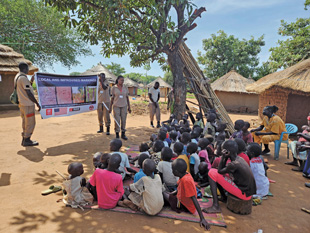
Children in South Sudan are taught about the risks of explosive hazards. Courtesy of MAG (Mines Advisory Group).
The majority of landmine and explosive remnants of war contamination in the Republic of South Sudan is found in Central, Eastern, and Western Equatoria, Jonglei, Unity, Upper Nile, and Western Bahr el Ghazal states. This inhibits delivery of humanitarian assistance, worsens food insecurity, impedes development, and threatens civilians.
From FY03 to FY10, the United States invested more than $24 million in conventional weapons destruction funding in Sudan prior to the creation of South Sudan, directing much of it to what is now South Sudan.
Following South Sudan’s independence, from FY11 to FY23, the United States invested more than $22 million in South Sudan for landmine and unexploded ordnance removal, as well as survivor assistance.
Between FY19 and FY23, the United States expanded its conventional weapons destruction programs to provide full survey and clearance activities, explosive ordnance disposal call-outs, and explosive ordnance risk education in Central and Eastern Equatoria states. This restart of systematic clearance efforts reflects a more permissive operating environment, despite continued violent unrest and access issues elsewhere in the country.
In FY23, the Department of State supported:
- Survey, clearance, explosive ordnance disposal call-outs, and explosive ordnance risk education in Central and Eastern Equatoria states.
|
Source |
FY11–20 |
FY21 |
FY22 |
FY23 |
TOTAL |
|
DOS NADR-CWD |
$16,135 |
$2,000 |
$2,000 |
$2,000 |
$22,135 |
|
DoD |
$826 |
$0 |
$0 |
$0 |
$826 |
|
Total |
$16,961 |
$2,000 |
$2,000 |
$2,000 |
$22,961 |
(Dollars in thousands)
FY23 South Sudan key performance metrics:
- 867,345 Sq m (214 acres) of land cleared
- 576 Explosive remnants of war destroyed
- 7,312 Explosive ordnance risk education recipients
- MAG (Mines Advisory Group)
Sudan
Sudan’s countryside is riddled with widespread landmine and explosive remnants of war contami-nation from civil wars and the armed conflict in Darfur, making it dangerous and difficult for human-itarian aid to reach priority areas. With U.S. funding, efforts have been made to prioritize explosive ordnance risk education, along with re-establishing coordination meetings between Sudan’s mine action and government authorities. As of April 2023, Sudan entered another challenging period due to fighting between the Sudanese Armed Forces and the Rapid Support Forces, resulting in a suspension of U.S-supported demining efforts across the country.
From FY03 to FY10, the United States invested more than $24 million in conventional weapons destruction funding in Sudan prior to the creation of South Sudan, directing much of it to what is now South Sudan.
From FY11 to FY23, the United States invested more than $5 million in conventional weapons destruction funding in Sudan.
In FY23 (with prior year funds), the Department of State supported:
- Coordination meetings including national mine action authorities, demining nongovernmental organizations, international donors, and other key stakeholders.
- Survey of explosive hazards.
- Explosive ordnance risk education in peace markets.
|
Source |
FY11–20 |
FY21 |
FY22 |
FY23 |
TOTAL |
|
DOS NADR-CWD |
$3,450 |
$1,000 |
$0 |
$1,000 |
$5,450 |
|
Total |
$3,450 |
$1,000 |
$0 |
$1,000 |
$5,450 |
(Dollars in thousands)
FY23 Sudan key performance metrics:
- 136 Explosive ordnance risk education recipients
- United Nations Mine Action Service
Zimbabwe
Zimbabwe still has dense anti-personnel minefields along its border with Mozambique dating back to the Zimbabwe Liberation War from 1964 to 1979, when Rhodesian Security Forces laid millions of landmines along the border with Mozambique. These minefields continue to kill and injure civilians and constrain economic development, particularly by killing livestock and preventing agricultural development. From FY98 to FY23, the United States invested more than $31 million for conventional weapons destruction in Zimbabwe. This assistance has returned a total of 14.3 million square meters (3,536 acres) of land to productive use and destroyed 76,295 landmines and other explosive hazards.
In FY23, the Department of State supported:
- Demining operations in Mashonaland, Mashonaland East, and Masvingo Provinces.
- Explosive ordnance risk education for at-risk communities.
- A campaign to raise public awareness about the threats posed by landmines and U.S. efforts to address the threat.
With funding from the Department of Defense, the Humanitarian Demining Research and Development Program partnered with The HALO Trust to evaluate three technologies developed by the program: a soil-sifting excavator attachment, the dual-sensor HSTAMIDS mine detector, and the GPZ-7000 detector. Additionally, in partnership with APOPO, their evaluations of the GPZ-7000 mine detector and the Vallon VMX-10 unexploded ordnance detector continued. Program technologies have been used to clear over 35,000 mines from approximately 1.8 million square meters (445 acres) of land since 2014.
|
Source |
FY98–20 |
FY21 |
FY22 |
FY23 |
TOTAL |
|
DOS NADR-CWD |
$19,684 |
$1,500 |
$3,000 |
$2,500 |
$26,684 |
|
DoD |
$4,337 |
$185 |
$253 |
$55 |
$4,830 |
|
Total |
$24,021 |
$1,685 |
$3,253 |
$2,555 |
$31,514 |
(Dollars in thousands)
FY23 Zimbabwe key performance metrics:
- 521,074 Sq m (129 acres) of land cleared
- 28 Explosive ordnance disposal call-outs
- 3,094 Explosive ordnance risk education recipients
- 14,450 Landmines destroyed
- APOPO, The HALO Trust
Regional Programs
Coastal West Africa: In 2019, the Global Fragility Act1 was signed into law and the U.S. Strategy to Prevent Conflict and Promote Stability2 was established for a whole-of-government approach to support various partner nations, including several Coastal West African countries. In 2022, the Coastal West Africa regional physical security and stockpile management program was established in tandem with the security-sector priorities laid out in the strategy. The program’s mission is to assess and address the weapons and ammunition management needs in Côte d’Ivoire, Ghana, Guinea-Bissau, and Togo.
In FY23 (with prior year funds), the Department of State supported:
Construction and refurbishment of weapons storage facilities.
Stockpile management training for partner nation security forces.
FY23 Coastal West Africa key performance metrics:
- 4.56 Metric tons of unserviceable ammunition destroyed
- 24 Personnel trained in stockpile management
- The HALO Trust
East Africa Regional Initiative: Across East Africa, long unguarded borders coupled with remote weapons and ammunition storage facilities create opportunities for transnational terrorist and criminal groups, and challenges for partners like Kenya and Tanzania. From FY06 to FY23, the United States provided more than $7 million in support of initiatives across East Africa to counter illicit small arms and light weapons proliferation.
In FY23 (with prior year funds), the Department of State supported:
Strengthening the Nairobi-based Regional Center on Small Arms in the Great Lakes Region’s capacity to provide physical security and stockpile management support and reduce the threat of proliferation in the Great Lakes region.
Training to bolster Kenyan and Tanzanian police capacity to effectively store, manage, and account for their stockpiles of weapons and ammunition.
Construction of mobile armories to prevent weapons diversion in border areas.
FY23 East Africa region key performance metrics:
- 68 Personnel trained in stockpile management
- 8 Armories built or rehabilitated
- The HALO Trust
Other U.S. Support
With funding from the Department of Defense:
- In Cabo Verde, U.S. Africa Command completed a holistic requirements determination site survey to research requirements and capability gaps in demining, explosive ordnance disposal, physical security and stockpile management, and emergency medical response.
- In Sierra Leone, U.S. Africa Command procured an explosive ordnance disposal Level 1 train-the-trainer classroom and instructor equipment for use by the Royal Sierra Leone Air Force.
- In Zambia, U.S. Africa Command worked with the Zambian Government and Ministry of Defense to begin their explosive ordnance disposal Level 1 program, subject-matter expertise, and initial physical security and stockpile management training.
With funding from USAID’s Leahy War Victims Fund:
- The World Health Organization integrated rehabilitation into existing healthcare systems; Catholic Relief Services improved mother and child health outcomes; and Data for Impact conducted program evaluation in Rwanda.
- As part of global programs, the World Health Organization and Results for Development integrated rehabilitation into existing healthcare systems in Ethiopia
- Johns Hopkins University-Bloomberg School of Public Health developed health systems that are responsive to growing needs for rehabilitation across the lifespan in Uganda.
Introduction
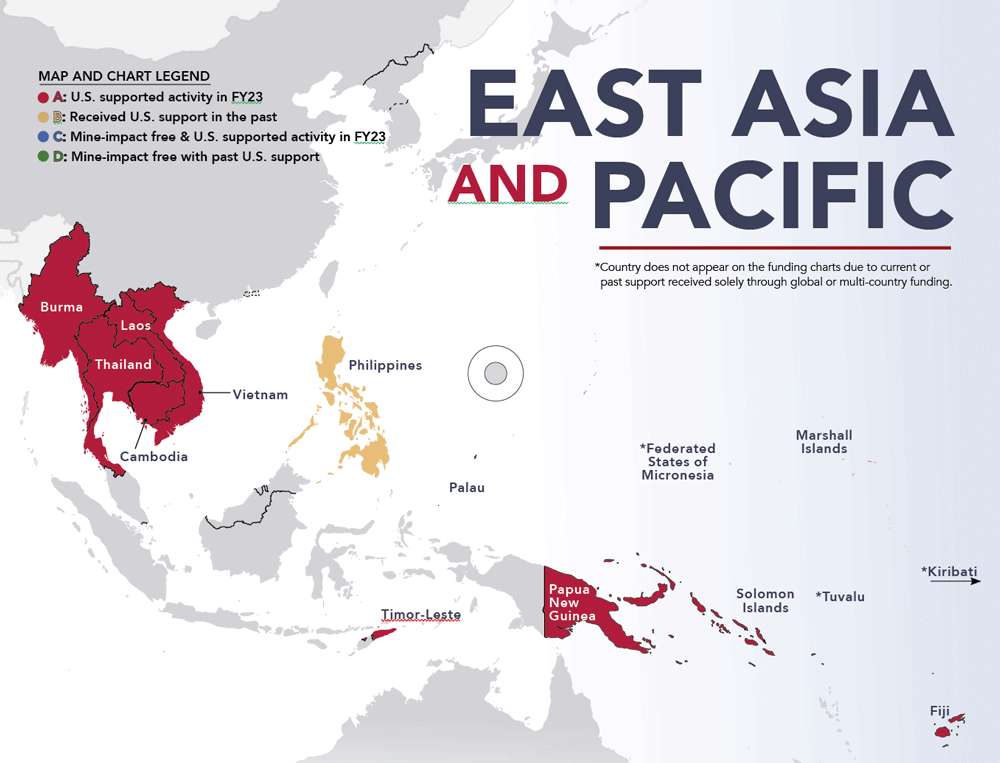
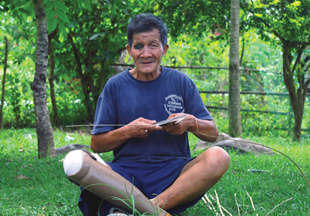
In 2010 Mr. La's eye was injured by and explosive hazard in Laos. In 2023, he received a cornea transplant through the War Victims Medical Fund funded by PM/WRA. Courtesy of Weld Education Inc.
Countless communities across East Asia and Pacific face lingering dangers from landmines and explosive remnants of war. Many Pacific Island nations are still contaminated with unexploded ordnance following World War II battles between Japanese and Allied forces, while Cambodia, Laos, and Vietnam face challenges from explosive hazards remaining from the Vietnam War and the Indochina Wars. In the decades since combat ended, strong economic development and population expansion into previously uninhabited areas continue to expose civilians to hidden landmines and explosive remnants of war. The United States is a global leader in addressing these emerging challenges, adjusting operational plans when weather-related incidents expose large air-dropped bombs that require immediate attention and adjusting operations when newly populated areas require assistance to find and remove explosive hazards.
For 30 years, U.S. conventional weapons destruction programs have been a bedrock of our diplomatic engagement in the region, helping expand our bilateral relationships, while creating a more prosperous and secure future. These investments to locate and remove explosive hazards save lives, deepen diplomatic ties, and open new economic opportunities. Cooperation to clear explosive hazard contamination was at the forefront of initial post-war reconciliation efforts in Southeast Asia and remains a foundation of the United States’ commitment to regional peace and prosperity.
Since 1993, the United States has invested more than $912 million in the East Asia and Pacific region for unexploded ordnance clearance, explosive ordnance risk education, assistance for survivors of landmine and unexploded ordnance accidents, local capacity building, and improving weapons and ammunition management.
FY23 cumulative performance metrics in East Asia and Pacific*
- 135,626,521 Sq m (33,514 acres) of land cleared
- 2,667 Landmines destroyed
- 11,449 Small arms/light weapons destroyed
- 2,916,941 Risk education recipients
- 99,077 Explosive remnants of war destroyed
- 209,163,128 Sq m (51,685 acres) cluster munition remnant survey
*(Metrics include total U.S. assistance across the region, not just key metrics from featured countries)
Allocation of $87.23 million to East Asia and Pacific in FY23 by country (dollars in thousands)
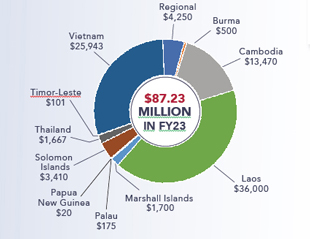
Top five countries funded in East Asia and Pacific FY93–FY23 (dollars in thousands)
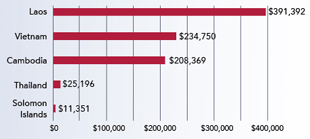
|
|
Country |
FY93-20 |
FY21 |
FY22 |
FY23 |
Total |
|
A |
Burma |
$9,035 |
$0 |
$0 |
$500 |
$9,535 |
|
A |
Cambodia |
$172,023 |
$10,361 |
$12,515 |
$13,470 |
$208,369 |
|
A |
Fiji |
$370 |
$1,330 |
$0 |
$0 |
$1,700 |
|
A |
Laos |
$270,388 |
$40,000 |
$45,004 |
$36,000 |
$391,392 |
|
A |
Marshall Islands |
$2,009 |
$0 |
$0 |
$1,700 |
$3,709 |
|
A |
Palau |
$5,327 |
$893 |
$495 |
$175 |
$6,890 |
|
A |
Papua New Guinea |
$0 |
$0 |
$12 |
$20 |
$32 |
|
B |
Philippines |
$3,023 |
$0 |
$0 |
$0 |
$3,023 |
|
A |
Solomon Islands |
$6,878 |
$0 |
$1,063 |
$3,410 |
$11,351 |
|
A |
Thailand |
$19,638 |
$1,443 |
$2,448 |
$1,667 |
$25,196 |
|
A |
Timor-Leste |
$0 |
$22 |
$344 |
$101 |
$467 |
|
A |
Vietnam |
$166,332 |
$19,587 |
$22,888 |
$25,943 |
$234,750 |
|
|
Regional |
$11,662 |
$0 |
$0 |
$4,250 |
$15,912 |
|
|
Total |
$666,685 |
$73,636 |
$84,769 |
$87,236 |
$912,325 |
CHART LEGEND
A: U.S. supported activity in FY23
B: Received U.S. support in the past
C: Mine-impact free & U.S. supported activity in FY23
D: Mine-impact free with past U.S. support
Clearing explosive remnants of war in Vietnam: Restoring precious farmland and food security
Article and images courtesy of PeaceTrees Vietnam.
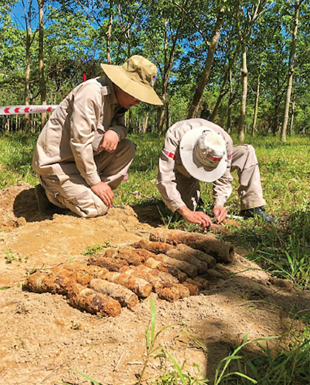
PeaceTrees Vietnam personnel prepare to destroy unexploded ordnance.
Almost 50 years after the end of the U.S.-Vietnam War, its legacy still shadows the lives of those living in central Vietnam. This post-war era is tainted by the lasting presence of unexploded bombs and other explosive remnants of war, all remnants of a past that continue to threaten the safety and security of local communities. Despite the relentless clearance efforts, life-altering accidents persist. This harrowing danger that lingers is why PeaceTrees Vietnam dedicates its efforts to post-conflict recovery. PeaceTrees Vietnam’s mission ensures that communities affected by conflict can live freely and embrace a future unburdened by the threat of unexploded ordnance.
In regions like Nam Trạch Commune, located within the Quảng Bình Province just north of the former Demilitarized Zone, the urgency of PeaceTrees Vietnam’s work cannot be overstated. During the war, this area bore the brunt of intense bombing campaigns, leaving behind a distressing legacy of 258 known cluster munition strike points.
Mr. Nguyễn Văn Chung, an 82-year-old farmer, is a poignant example of these difficult post-war challenges and the help brought about by PeaceTrees Vietnam, funded in part by the U.S. Department of State’s Office of Weapons Removal and Abatement. Mr. Chung, in his determination to provide for his family, had been cultivating a 2.5-acre plot of land that had long been rendered unusable due to unexploded ordnance, specifically unexploded cluster munitions. His decision to work the perilous land, despite knowing the potential risks, exemplifies the stark choices families face. Mr. Chung shared, “I knew this field was contaminated with cluster munitions. My family does not have much land for cultivation. I decided to ... use this area anyway. Honestly, I did not expect so many sub-munitions would be found there.” PeaceTrees Vietnam found and destroyed 104 dangerous submunitions in Mr. Chung’s rice field.
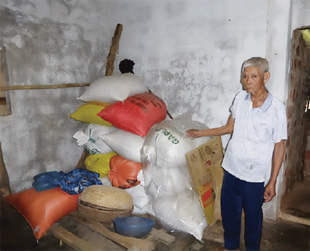
Mr. Chung with his rice harvest.
When PeaceTrees Vietnam teams visited Mr. Chung months later for a post-clearance assessment, he excitedly shared how the unexploded ordnance clearance has allowed his family to prosper: “My family harvested 4.5 tons of rice from the field. I sold some to cover our living costs and to invest in the next crop. Thank you for clearing the field so my family and others can work there safely in the future.” The implications of this transformation for Mr. Chung and his family are profound. Not only were they able to secure their livelihoods through rice sales when they had been harvesting only enough for the family to eat, but they could also invest in future crops without the constant fear of hidden explosives.
PeaceTrees Vietnam’s impact resonates on a broader scale, reflecting the community-wide transformation unfolding in central Vietnam thanks to PeaceTrees Vietnam’s dedicated efforts. The clearance and cultivation of rice fields represents the transformation of entire communities into safe spaces conducive to education, productivity, and, fundamentally, peace.
Cambodia
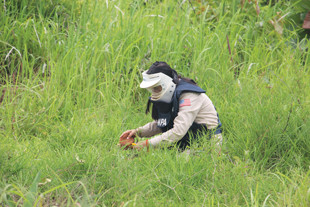
In Cambodia work continued on cluster munition remnant survey and clearance. Courtesy of Norwegian People’s Aid.
Cambodia faces a diverse range of challenges from explosive remnants of war. U.S. air strikes during the Vietnam War over its eastern and northeastern regions as well as internal conflicts left significant amounts of unexploded ordnance. Extensive minefields were also laid by the Khmer Rouge, Royal Cambodian Armed Forces, and Vietnamese and Thai militaries during the Indochina Wars and Vietnamese occupation, especially along a 750-kilometer mined area on the Thai border known as the K5 mine belt.
From FY93 to FY23, the United States invested more than $208 million in conventional weapons destruction programs in Cambodia to locate and clear explosive hazards, support national capacity development, enhance weapons and ammunition management, and provide explosive ordnance risk education.
In FY23, the Department of State supported:
- Teams working to clear dense anti-personnel and anti-tank minefields in the K5 mine belt in northwestern Cambodia.
- Continuing Cluster Munition Remnant Survey in eastern Cambodia to identify new priority hazards for clearance.
- The continued partnership with the Cambodian government to fund survey and clearance teams operated by the Cambodian Mine Action Center in eastern Cambodia.
- Capacity building and support to a local non-government organization to conduct survey and clearance in northwestern Cambodia.
- Explosive ordnance risk education, reducing the risk of accidents and injuries in communities throughout the country.
- An explosive harvesting program to repurpose explosive material from excess ammunition stockpiles into demolition charges used by humanitarian clearance organizations to destroy explosive hazards.
- Training for Royal Cambodian Armed Forces personnel at its military technical academy to improve capacity to manage weapons and ammunition, including reduction of obsolete or expired state-held stocks of small arms, light weapons, and ammunition.
With funding from the Department of Defense, the Humanitarian Demining Research and Development Program partnered with MAG (Mines Advisory Group) to perform technology testing through survey and clearance in Battambang and Ratanakiri Provinces. Program technologies have cleared approximately 49 million square meters (12,108 acres) of land and approximately 45,700 mines and unexploded ordnance to date.
| Source |
FY93–20 |
FY21 |
FY22 |
FY23 |
TOTAL |
|
DOS NADR-CWD |
$122,747 |
$9,000 |
$12,000 |
$12,000 |
$155,747 |
|
DOS Other |
$4,943 |
$0 |
$0 |
$0 |
$4,943 |
|
CDC |
$100 |
$0 |
$0 |
$0 |
$100 |
|
DoD |
$29,149 |
$1,361 |
$515 |
$1,470 |
$32,495 |
|
USAID |
$15,084 |
$0 |
$0 |
$0 |
$15,084 |
|
Total |
$172,023 |
$10,361 |
$12,515 |
$13,470 |
$208,369 |
(Dollars in thousands)
FY23 Cambodia key performance metrics:
- 39,746,564 Sq m (9,822 acres) of land cleared
- 35,520,107 Sq m (8,777 acres) of Cluster Munition Remnant Survey
- 3,380 Explosive ordnance disposal call-outs
- 2,619 Landmines destroyed
- 20,612 Explosive remnants of war destroyed
- 42,243 Explosive ordnance risk education recipients
- 40.03 Metric tons of unserviceable ammunition destroyed
- 11,449 Small arms and light weapons destroyed.
- Golden West Humanitarian Foundation, The HALO Trust, Humanity & Inclusion, MAG (Mines Advisory Group), Norwegian People’s Aid
Fiji
Republic of Fiji Military Forces maintain explosive ordnance disposal capability and capacity for regional and global response to explosive hazards.
From FY20 to FY23, the United States invested more than $1 million in conventional weapons destruction programs in Fiji to enhance explosive ordnance disposal capacity and capability.
In FY23, the Department of State supported (with prior year funds):
- Continuing capacity development through explosive ordnance disposal training Level 1 and 2 to Republic of Fiji Military Forces personnel.
|
Source |
FY20 |
FY21 |
FY22 |
FY23 |
TOTAL |
|
DOS NADR-CWD |
$370 |
$1,330 |
$0 |
$0 |
$1,700 |
|
Total |
$370 |
$1,330 |
$0 |
$0 |
$1,700 |
(Dollars in thousands)
FY23 Fiji key performance metrics:
- 23 Personnel trained in stockpile management
- Golden West Humanitarian Foundation
Laos
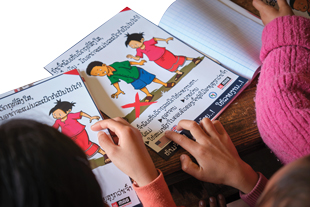
Explosive ordnance risk education books designed for children in Laos. Courtesy of MAG (Mines Advisory Group).
The United States’ commitment to the people of Laos will continue to enable clearance of unexploded ordnance. Laos contains some of the highest levels of unexploded ordnance in the world, a majority of which are from U.S. aerial bombing campaigns conducted during the Vietnam War. Unexploded ordnance from that war remain in most of the country’s provinces and continue to cause civilian casualties. FY23 marked a significant milestone, as proactive Cluster Munition Remnant Surveys were completed in Attapeu, Champasak, Salavan, Savannakhet, and Sekong Provinces. These surveys identified areas with unexploded ordnance and will help focus clearance operations on areas known to contain cluster munition remnants—speeding up the return of land to safe use.
From FY95 to FY23, the United States invested more than $391 million in conventional weapons destruction programs in Laos to conduct survey and clearance of unexploded ordnance, explosive ordnance risk education, survivor assistance, and capacity development.
In FY23, the Department of State supported:
- Cluster Munition Remnant Survey and clearance operations in six provinces (Attapeu, Champasak, Salavan, Savannakhet, Sekong, and Xiengkhouang) and destruction of significant amounts of unexploded ordnance through explosive ordnance disposal rapid response based on community requests.
- Operations of the national unexploded ordnance operator, unexploded ordnance Lao, at its headquarters in Vientiane and through survey and clearance teams in Khammouane, Savannakhet, Salavan, and Attapeu Provinces.
- The National Regulatory Authority’s work overseeing the mine action sector in Laos, including a new project to enhance information management and improve the national database that tracks known hazardous areas.
- A comprehensive study to improve ongoing explosive ordnance risk education programs and identify best practices to enhance monitoring and evaluation of these efforts.
- Diversified explosive ordnance risk education through a variety of messaging in social media, radio, and print as well as in secondary schools and non-formal community-based education centers.
- The War Victims Medical Fund,1 funded by the U.S. government, provides immediate medical treatment and associated costs for unexploded ordnance casualties and their families, as well as certain funeral costs and family support for fatal unexploded ordnance accidents.
With previous year funding from USAID, the Leahy War Victims Fund continued to support World Education, Inc.(which administers the War Victim’s Medical Fund) to provide independent living support programs to persons with disabilities, and the World Health Organization to integrate rehabilitation into existing healthcare systems.
|
Source |
FY95–20 |
FY21 |
FY22 |
FY23 |
TOTAL |
|
DOS NADR-CWD |
$241,864 |
$40,000 |
$45,000 |
$36,000 |
$362,864 |
|
DOS Other |
$750 |
$0 |
$0 |
$0 |
$750 |
|
DoD |
$7,053 |
$0 |
$4 |
$0 |
$7,057 |
|
USAID |
$20,721 |
$0 |
$0 |
$0 |
$20,721 |
|
Total |
$270,388 |
$40,000 |
$45,004 |
$36,000 |
$391,392 |
(Dollars in thousands)
FY23 Laos key performance metrics:
- 41,150,467 Sq m (10,169 acres) of land cleared
- 128,698,021 Sq m (31,802 acres) of Cluster Munition Remnant Survey
- 3,627 Explosive ordnance disposal call-outs
- 46 Landmines destroyed
- 51,147 Explosive remnants of war destroyed
- 151,617 Explosive ordnance risk education recipients
- 29 Survivor assistance recipients
- Center for International Stabilization and Recovery, The HALO Trust, MAG (Mines Advisory Group), Norwegian People’s Aid, Tetra Tech, World Education, Inc., World Health Organization
https://worlded.org/project/war-victims-medical-fund-wvmf/
Marshall Islands
Despite clearance efforts in the 1950s, U.S. and Japanese-origin unexploded ordnance contamination from World War II remain in the Marshall Islands.
From FY13 to FY23, the United States invested more than $3 million in conventional weapons destruction programs in the Marshall Islands to locate and mark unexploded ordnance, destroy known unexploded ordnance, and provide explosive ordnance risk education.
In FY23, the Department of State supported:
- Finding and destroying unexploded ordnance across various islands of Maloelap Atoll. The United States also partnered with local police and the Marshall Islands’ Historic Preservation Office to mark unexploded ordnance sites with information provided by local citizens, as well as provide explosive ordnance risk education to local citizens.
|
Source |
FY13–20 |
FY21 |
FY22 |
FY23 |
TOTAL |
|
DOS NADR-CWD |
$2,009 |
$0 |
$0 |
$1,700 |
$3,709 |
|
Total |
$2,009 |
$0 |
$0 |
$1,700 |
$3,709 |
(Dollars in thousands)
FY23 Marshall Islands key performance metrics:
- 43 Explosive remnants of war destroyed
- 90 Explosive ordnance risk education recipients
- Golden West Humanitarian Foundation
Palau
Many of Palau’s islands remain contaminated with unexploded ordnance from major World War II battles between Japanese and Allied Forces, especially on the islands of Anguar, Babeldaob, and Peleliu.
From FY09 to FY23, the United States invested more than $6 million in conventional weapons destruction programs in Palau to locate and mark unexploded ordnance for the national database and destroy known unexploded ordnance.
In FY23, the Department of State supported (with prior year funds):
- Survey operations to identify and record explosive hazards in the national database as well as locate and destroy known unexploded ordnance according to Palau’s annual unexploded ordnance plan. The United States also began unexploded ordnance operations in Peleliu.
- Planning with the Bureau of Public Safety to enhance its weapons and ammunition management practices.
With funding from the Department of Defense, the Humanitarian Demining Research and Development Program partnered with Norwegian People’s Aid to continue evaluating the mobile bomb cutter in Palau. To date, the cutter has destroyed more than 2,000 pieces of World War II-era unexploded ordnance.
| Source |
FY09–20 |
FY21 |
FY22 |
FY23 |
TOTAL |
|
DOS NADR-CWD |
$5,111 |
$820 |
$380 |
$60 |
$6,371 |
|
DOD |
$216 |
$73 |
$115 |
$115 |
$519 |
|
Total |
$5,327 |
$893 |
$495 |
$175 |
$6,890 |
(Dollars in thousands)
FY23 Palau key performance metrics:
- 28 Explosive ordnance disposal call-outs
- 190 Explosive remnants of war destroyed
- Norwegian People’s Aid
Solomon Islands
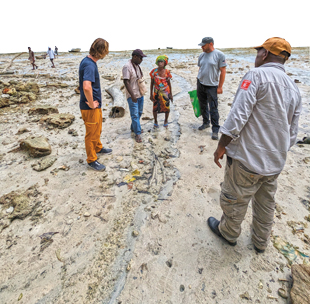
A U.S.-funded survey team in Solomon Islands talks with a local community member about the location of explosive hazards she has seen in the area. Courtesy of Department of State.
Solomon Islands was the site of major battles between Japan and Allied forces and remains contaminated with unexploded ordnance from World War II.
From FY11 to FY23, the United States invested more than $11 million for conventional weapons destruction programs in Solomon Islands for locating and marking unexploded ordnance, supporting updates to the national unexploded ordnance database, and national capacity support.
In FY23, the Department of State supported (with prior year funds):
- Continuation of non-technical survey to locate and mark unexploded ordnance for the national unexploded ordnance database. This identifies and prioritizes unexploded ordnance for Royal Solomon Islands Police Force explosive ordnance disposal teams to conduct removal and destruction of known explosive hazard contamination.
With funding from the Department of Defense, U.S. Indo-Pacific Command purchased equipment, developed a concept of operations and curriculum, planned tentative training events, and designed physical infrastructure improvements to build the Royal Solomon Islands Police Force’s humanitarian mine action capacity.
|
Source |
FY11–20 |
FY21 |
FY22 |
FY23 |
TOTAL |
|
DOS NADR-CWD |
$4,688 |
$0 |
$1,000 |
$0 |
$5,688 |
|
DOS Other |
$0 |
$0 |
$0 |
$2,500 |
$2,500 |
|
DoD |
$2,190 |
$0 |
$63 |
$910 |
$3,163 |
|
Total |
$6,878 |
$0 |
$1,063 |
$3,410 |
$11,351 |
(Dollars in thousands)
FY23 Solomon Islands key performance metrics:
- 59 Explosive ordnance disposal call-outs
- 221 Explosive remnants of war destroyed
- 0.86 Metric tons of unserviceable ammunition destroyed
- The HALO Trust
Vietnam
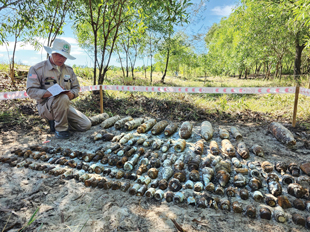
Cleared explosive hazards in Vietnam are prepared for safe destruction. Courtesy of Norwegian People's Aid.
Vietnam remains heavily impacted by unexploded ordnance from 30 years of conflict during the Indochina Wars and the Vietnam War. Most of the unexploded ordnance are cluster munitions that are concentrated in provinces near the former Demilitarized Zone, including Quang Binh, Quang Tri, Ha Tinh, Thua Thien Hue, and Quang Nam Provinces. Unexploded ordnance also remains in parts of southern Vietnam, and landmine contamination persists along its northern border with China.
From FY93 to FY23, the United States invested more than $234 million for conventional weapons destruction programs in Vietnam that cleared explosive hazards, provided explosive ordnance risk education and survivor assistance to impacted communities, and supported national capacity development. President Biden highlighted the important role that unexploded ordnance clearance has played in developing bilateral trust and respect between the United States and Vietnam in the Joint Statement with General Secretary Nguyen Phu Trong as part of the historic upgrade to a Comprehensive Strategic Partnership in September 2023.
In FY23, the Department of State supported:
- Large-scale survey and clearance operations in the central provinces of Quang Tri and Quang Binh, which have the highest concentration of U.S.-origin unexploded cluster munitions. This included the completion of surveys in accessible communities in Quang Tri, allowing U.S. funding to prioritize operations to remove known explosive hazards in the province.
- Operations in Thua Thien Hue Province to enhance the technical capacity of the national mine action authority in the field, as well as identify and clear high-priority sites with explosive hazard contamination.
- The Vietnam National Mine Action Center and two provincial mine action coordination offices. With the provision of a technical advisor, information management support, and humanitarian mine action capacity building, the United States is helping develop Vietnam’s expertise to carry out a national humanitarian mine action program independent of U.S. assistance.
- Explosive ordnance risk education in primary and secondary schools in Da Nang, Quang Binh, Quang Nam, Quang Tri, and Thua Thien Hue Provinces.
With funding from the Department of Defense:
- The Humanitarian Demining Research and Development Program partnered with Norwegian People’s Aid to continue evaluating the Scorpion unexploded ordnance detection system and the Bearcat vegetation clearance system. In partnership with MAG (Mines Advisory Group), evaluation continued on two area preparation vegetation removal attachments and a rotary sifter for mine and unexploded ordnance clearance, and a new Traxx Robomax area preparation system. These technologies have been used in the clearance of over 6,700 mines and unexploded ordnance from approximately 3.7 million square meters (914 acres) of land to date.
- U.S. Indo-Pacific Command conducted three International Mine Action Standards and explosive ordnance disposal casualty care training engagements, three train-the-trainer events for new nongovernmental organizations, three mentorship sessions, and a pre-deployment site survey to engage the Vietnam National Mine Action Center on the status of the program and a recommended way forward. U.S. Indo-Pacific Command also coordinated final infrastructure design for an improved field complex for training for International Mine Action Standards training events.
As part of global funding, USAID's Leahy War Victims Fund supported Vietnam’s rehabilitation sector and integrated rehabilitation into existing healthcare systems.
|
Source |
FY93–20 |
FY21 |
FY22 |
FY23 |
TOTAL |
|
DOS NADR-CWD |
$131,480 |
$18,200 |
$21,620 |
$25,000 |
$196,300 |
|
CDC |
$1,848 |
$0 |
$0 |
$0 |
$1,848 |
|
DoD |
$6,205 |
$1,387 |
$1,268 |
$943 |
$9,803 |
|
USAID |
$26,799 |
$0 |
$0 |
$0 |
$26,799 |
|
Total |
$166,332 |
$19,587 |
$22,888 |
$25,943 |
$234,750 |
(Dollars in thousands)
FY23 Vietnam key performance metrics:
- 54,729,490 Sq m (13,524 acres) of land cleared
- 44,945,000 Sq m (11,106 acres) of Cluster Munition Remnant Survey
- 3,417 Explosive ordnance disposal call-outs
- 26,864 Explosive remnants of war destroyed
- 2,722,981 Explosive ordnance risk education recipients
- Catholic Relief Services, MAG (Mines Advisory Group), Norwegian People’s Aid, PeaceTrees Vietnam, World Health Organization
Regional Programs
Cambodia, Laos, Palau, Thailand, and Vietnam continued receiving U.S. support through the Geneva International Centre for Humanitarian Demining, over and above the United States’ bilateral conventional weapons destruction assistance to those countries. This builds on previous assistance to help authorities conduct long-term risk management. This project addresses the physical risks from explosive remnants of war and builds the national capacity of mine action authorities and governments to create long-lasting success in managing clearance of landmines and explosive remnants of war.
Other U.S. Support
Burma: With prior year funding from USAID’s Leahy War Victims Fund, the United Nations Office for Project Services, through small grants to local nongovernmental organizations, worked to ensure civilian victims of conflict and persons with disabilities have access to health, rehabilitation, and assistive technology services; provided support to their families and communities; and supported Johns Hopkins University-Bloomberg School of Public Health to strengthen localized nongovernmental health systems that are responsive to rehabilitation needs across survivors’ lifespans as part of a global program.
With funding from the Department of Defense:
- Papua New Guinea: U.S. Indo-Pacific Command conducted a holistic requirements determination site survey with the Papua New Guinea Defense Forces to research requirements and capability gaps in demining, explosive ordnance disposal, physical security and stockpile management, and emergency medical response.
- Timor-Leste: U.S. Indo-Pacific Command assisted Timor-Leste in establishing its indigenous humanitarian mine action capacity by conducting the Phase III explosive ordnance disposal Level 3/Blast Trauma, Pre-Deployment Site Survey, and Phase IV explosive ordnance disposal Level 3+ train-the-trainer engagements.
- Thailand: The Humanitarian Demining Research and Development Program partnered with the Thailand Mine Action Center to continue evaluation of the Mini MineWolf earth tilling system and armored remote control chase vehicle. The program also deployed two new Bearcat area preparation systems and two new Rambo support systems.
U.S. Indo-Pacific Command continued to support Thailand’s detection and clearance programs to reduce the social, economic, and environmental impact of landmines and explosive remnants of war. Marines of 9th Engineer Support Battalion, 3rd Marine Logistics Group attended the Thailand Mine Action Center International Day for Mine Awareness and Assistance in Mine Action in Trat, Thailand, to show support on behalf of U.S. Marine Corps Forces, Pacific, and U.S. Indo-Pacific Command; and also conducted an explosive ordnance disposal team leader special charge training event for explosive ordnance disposal Level 3 curriculum and practical application. In addition, 9th Engineer Support Battalion personnel conducted a humanitarian mine action unit team leader course with host nation personnel in Ratchaburi, Thailand, to increase partner nation capacity.
Europe
- Introduction
- Mechanical Mine Clearance in Ukraine’s Liberated Areas: Paving the way for returning communities and economic development
- Albania
- Bosnia and Herzegovina
- Bulgaria
- Croatia
- Georgia
- Kosovo
- Serbia
- Slovakia
- Ukraine
- Regional Programs
- Other U.S. Support
- Back to Regions Menu
- Bosnia and Herzegovina: Managing Wildfires with Humanitarian Mine Action
Introduction
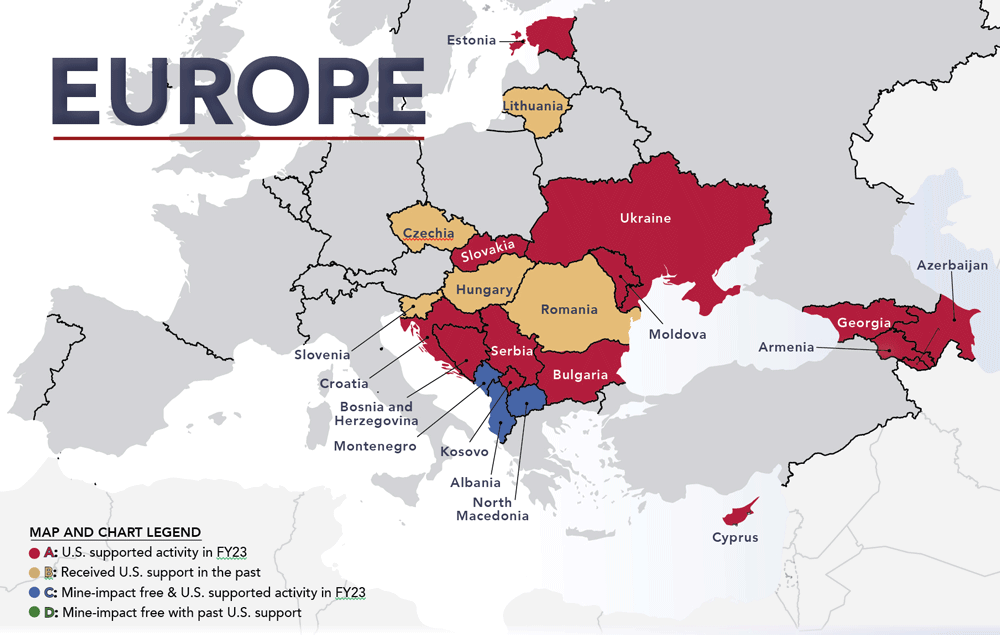
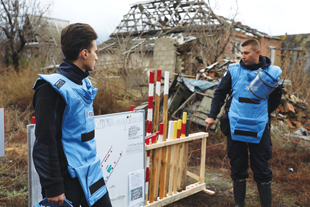
Deminers in Ukraine are briefed on the day’s task. Courtesy of Fondation suisse de déminage.
The U.S. conventional weapons destruction program continues to support regional security, national capacity building, and economic development in Eastern Europe and the western Balkans. Funding from the United States and other donors has freed much of Southeast Europe from the impact of landmines and explosive remnants of war, quickly expanded Ukraine’s demining efforts since Russia’s illegal, full-scale invasion in February 2022, and significantly reduced stockpiles of unserviceable and unstable munitions throughout the region.
The U.S. Government’s investment in physical security and stockpile management helps reduce the risk of illicit diversion of small arms and light weapons to criminals and prevents accidental explosions at depots storing excess, obsolete, and aging ammunition. In FY23, U.S.-funded projects across the region continued to help partner countries properly store their weapons and ammunition stockpiles and to properly dispose of unstable or unserviceable ammunition according to international standards.
Since Russia’s further aggression against Ukraine in February 2022, the United States has taken concrete steps to strengthen its abilities and those of its partners to counter conventional weapons diversion, improve border security, and provide law enforcement capacity-building with the implementation of the U.S. Plan to Counter Illicit Diversion of Certain Advanced Conventional Weapons in Eastern Europe.
The Department of State’s Interagency MANPADS Task Force collaborated with allies and partners (including France, Germany, United Kingdom, the European Union, and others) to reduce the risk of illicit trafficking of certain advanced conventional weapons by providing nearly 400 border guards and law enforcement officials with MANPADS and anti-tank guided missile recognition training.
Clearing explosive hazards from the Yugoslav wars in the Balkans and from Russia’s full-scale invasion of Ukraine helps families to return to their homes, enables recovery efforts, and promotes economic development. In FY23, Ukraine continued to rapidly expand its national demining program to respond to the massive amounts of explosive hazards resulting from Russia’s horrific invasion. Thanks to support from the United States and other donors, Ukraine and its partners deployed 3,000 deminers in areas liberated from Russia’s forces as of September 2023. In FY23, U.S. funded projects cleared explosive hazards, while also building Ukraine’s capacity to address explosive hazard contamination over the long term. The United States also continues to provide explosive ordnance risk education to vulnerable people and communities.
Conventional weapons destruction is a key component of U.S. diplomatic outreach to partner countries in Eastern Europe and the Balkans. The United States’ investments in landmine and unexploded ordnance clearance, survivor assistance, explosive ordnance risk education, and physical security and stockpile management deepen and foster relationships based on saving lives and improving regional security.
Since 1993, the United States has invested more than $751 million in Europe for explosive hazard clearance, risk education, survivor assistance, improved stockpile security and destruction of excess munitions.
FY23 cumulative key performance metrics in Europe (Metrics include total U.S. assistance across the region, not just key metrics from featured countries)
- 2,804,129s q m (692 acres) of land cleared
- 650 Landmines destroyed
- 551 Explosive ordnance disposal call-outs
- 149,704 Risk education recipients
- 2,785 Explosive remnants of war destroyed
- 904.92 Metric tons of ammunition destroyed
Allocation of $113.12 million allocated to Europe in FY23 by country (dollars in thousands)
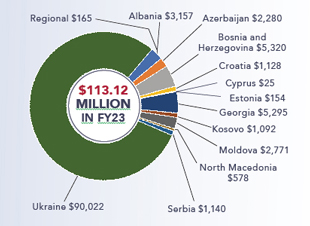
Top five countries funded in Europe FY93-FY23 (dollars in thousands)
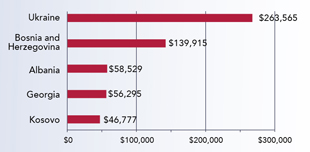
|
|
Country |
FY93-20 |
FY21 |
FY22 |
FY23 |
Total |
|
C |
Albania |
$50,079 |
$1,413 |
$3,880 |
$3,157 |
$58,529 |
|
A |
Armenia1 |
$14,205 |
$0 |
$0 |
$0 |
$14,205 |
|
A |
Azerbaijan |
$30,971 |
$500 |
$4,225 |
$2,280 |
$37,976 |
|
A |
Bosnia and Herzegovina |
$124,308 |
$4,422 |
$5,865 |
$5,320 |
$139,915 |
|
A |
Bulgaria |
$12,530 |
$300 |
$0 |
$0 |
$12,830 |
|
A |
Croatia |
$42,189 |
$2,213 |
$1,005 |
$1,128 |
$46,535 |
|
A |
Cyprus |
$621 |
$0 |
$25 |
$25 |
$671 |
|
B |
Czechia |
$600 |
$0 |
$0 |
$0 |
$600 |
|
A |
Estonia |
$5,216 |
$0 |
$704 |
$154 |
$6,074 |
|
A |
Georgia |
$43,145 |
$1,980 |
$5,875 |
$5,295 |
$56,295 |
|
B |
Hungary |
$350 |
$0 |
$0 |
$0 |
$350 |
|
A |
Kosovo |
$42,668 |
$1,497 |
$1,520 |
$1,092 |
$46,777 |
|
B |
Lithuania |
$500 |
$0 |
$0 |
$0 |
$500 |
|
A |
Moldova |
$4,405 |
$2,189 |
$1,420 |
$2,771 |
$10,785 |
|
C |
Montenegro |
$12,526 |
$1,700 |
$0 |
$0 |
$14,226 |
|
C |
North Macedonia |
$2,691 |
$357 |
$479 |
$578 |
$4,105 |
|
B |
Romania |
$2,519 |
$0 |
$0 |
$0 |
$2,519 |
|
A |
Serbia |
$23,540 |
$1,294 |
$1,430 |
$1,140 |
$27,404 |
|
B |
Serbia and Montenegro2 |
$5,646 |
$0 |
$0 |
$0 |
$5,646 |
|
A |
Slovakia |
$1,000 |
$0 |
$0 |
$0 |
$1,000 |
|
B |
Slovenia |
$270 |
$0 |
$0 |
$0 |
$270 |
|
A |
Ukraine |
$69,269 |
$13,798 |
$90,476 |
$90,022 |
$262,565 |
|
|
Regional |
$375 |
$0 |
$0 |
$165 |
$540 |
|
|
Total |
$489,623 |
$31,663 |
$116,904 |
$113,127 |
$751,317 |
CHART LEGEND
A: U.S. supported activity in FY23
B: Received U.S. support in the past
C: Mine-impact free3 & U.S. supported activity in FY23
D: Mine-impact free3 with past U.S. support
- Countries with activities in FY23 that were solely funded through Global/Multi-Country funding but received direct funding in the past.
- Serbia and Montenegro split into two countries in 2007.
- For purposes of this document, countries denoted as mine impact free are countries that are free from the dangers of landmines to the general population but not necessarily free from all land mines.
Mechanical Mine Clearance in Ukraine’s Liberated Areas: Paving the way for returning communities and economic development
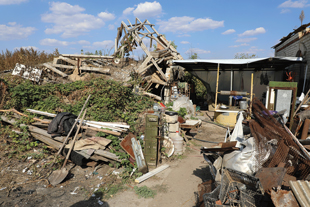
A damaged house in the village of Kamianka, Ukraine.
Kamianka, a rustic settlement in Ukraine’s east, experienced brutal fighting during the summer of 2022. Following months of fierce combat, Ukrainian troops finally retook Kamianka as part of their wider counter-offensive that liberated large parts of Kharkiv Oblast from Russian invaders in September 2022.
Unfortunately, according to Volodymyr K., a resident of Kamianka, “most of the houses in the village are destroyed and only their foundations and rubble remain. Nevertheless,” he adds, “people are still dream of returning to their homes and live in peace and safety.” Larisa S., another resident of Kamianka, concurs: “This is our motherland. My father built our house, and my husband assisted him. Even if only the foundations of our house were left, we would start rebuilding our home.”
In addition to the destruction, however, the months of intense combat had left Kamianka and its surrounding lands contaminated with explosive hazards. After farming for 23 years, Volodymyr found himself without the means of support, as his fields were no longer safe to work. Similarly, Larisa made the shocking discovery that “here in Kamianka everything was sown with them. The territory of the village was covered with Russian [anti-personnel] mines.”
Volodymyr recounts, “accidents happen on a regular basis.” He knew of farmers who were killed by explosive ordnance only days before FSD interviewed him: “They decided not to wait for assistance and started clearing their land by themselves. Unfortunately, they had fatal accidents. It is frustrating to realize that people are dying not only on the front line, but when trying to provide a future for their families and their nation.”
Larisa recounts that about ten people were injured in Kamianka alone: “We know the victims, because they are our fellow villagers. One man’s eye was damaged when a [anti-personnel] mine exploded, others had their feet torn off. About two weeks ago, a 14-year-old boy was injured.”
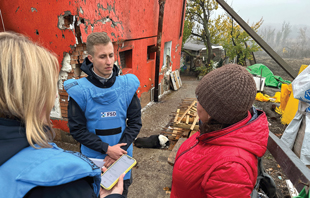
FSD talks with a local citizen to help identify contaminated areas of town.
In response to the danger, FSD has embarked on the urgent task of clearing explosive hazards from the village and its surroundings, supported by funding from the Department of State’s Office of Weapons Removal and Abatement. Since deploying to Kamianka, FSD’s demining assets have swept over 535,000 square meters (132 acres) of land so far, destroyed more than 50 Russian anti-personnel mines, and discovered numerous unexploded 152 mm projectiles.
When Volodymyr learned about the clearance, he showed much enthusiasm: “For my family, it’s like a sunrise, we now start to see a bright future. As FSD continues clearance, we understand that the process is not fast, that we need to be patient.
Larisa shares this optimism: “In addition to dreaming about the end of the war, we also dream of rebuilding our native village. We used to have a big, beautiful village, and we want it to be restored and for villagers to come back to it. We hope that the experts from FSD will complete the demining process soon so the area around the village will be safe.” Larisa also speaks about the daily satisfaction of seeing yet another part of the village has been demined. “It inspires and gives you hope. With every square meter cleared we can see the village returning to peaceful life.”
Albania
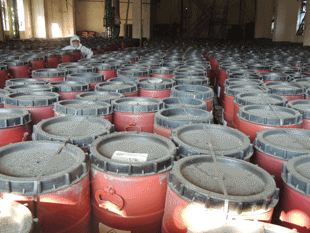
Barrels of ash waste from ammunition disposal in Albania await disposal. Courtesy of ITF Enhancing Human Security.
Albania declared itself mine free in 2009, but unexploded ordnance remains at some former military ranges and sites of unplanned depot explosions, known as ‘hotspots.’ The government of Albania continues to work towards clearing the final remaining hotspots.
From FY00 to FY23, the United States invested more than $58 million in Albania to clear hotspots, build an enduring Albanian national clearance capacity, enhance stockpile security, and conduct safe munitions disposal.
In FY23, the Department of State supported:
- Continued security upgrades to Ministry of Interior ammunition and weapons storage facilities. These upgrades make facilities safer and compliant with international standards and include more secure weapons storage for the Albanian State Police. These upgrades will be completed during FY24.
- Ongoing activities to safely dispose of waste generated by prior ammunition destruction activities.
- With funding from the Department of Defense:
- The New Jersey National Guard and U.S. Marine Corps Forces Europe provided a train-the-trainer course on International Mine Action Standards explosive ordnance disposal Level 3.
- Ammunition subject-matter experts from the U.S. National Guard completed a physical security and stockpile management foundation course with the Albanian Ministry of Defense compliant with the International Ammunition Technical Guidelines.
- U.S. European Command continued renovations at two ammunition storage facilities at Miraka and the Zall-Her to reduce the risk of unplanned explosions at munition sites. In addition, technical assistance in class V accounting systems, introduction to risk management, and basic introduction to ammunition and physical security and stockpile management continued.
- U.S. European Command continued technical assistance with the Albanian Interagency on updating national regulations to follow international best practices.
|
Source |
FY00–20 |
FY21 |
FY22 |
FY23 |
TOTAL |
|
DOS NADR-CWD |
$44,247 |
$750 |
$500 |
$500 |
$45,997 |
|
DoD |
$4,443 |
$663 |
$3,380 |
$2,657 |
$11,143 |
|
USAID |
$1,389 |
$0 |
$0 |
$0 |
$1,389 |
|
Total |
$50,079 |
$1,413 |
$3,880 |
$3,157 |
$58,529 |
(Dollars in thousands)
FY23 Albania key performance metrics:
- Armories being built or rehabilitated under this program will be completed in FY24.
- ITF Enhancing Human Security, United Nations Development Programme-South Eastern Europe Clearing House for the Control of Small Arms and Light Weapons
Bosnia and Herzegovina
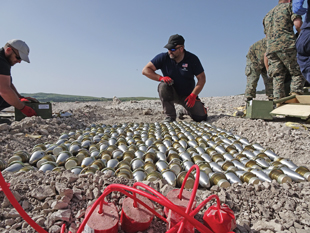
A Tetra Tech demolition team unpacks and lays out fuzes for demolition in Bosnia and Herzegovina. Courtesy of Tetra Tech.
Thirty years after the breakup of Yugoslavia and subsequent regional conflicts, Bosnia and Herzegovina remains heavily contaminated with explosive hazards. Most remaining minefields are in formerly contested areas along the separation line between Bosnia and Herzegovina’s two entities: the Federation of Bosnia and Herzegovina and the Republika Srpska. As of September 2023, the Bosnia and Herzegovina Mine Action Center estimated that more than 849 million square meters (209,792 acres) of its territory may still be contaminated with explosive hazards.
From FY96 to FY23, the United States invested more than $139 million in Bosnia and Herzegovina to clear landmines, provide explosive ordnance risk education and survivors assistance, and destroy unserviceable munitions stockpiles.
In FY23, the Department of State supported:
- Survey and clearance operations across Bosnia and Herzegovina.
- A program to connect schools in Bosnia and Herzegovina with schools in the United States as a part of the broader Children Against Mines Program.
- Explosive ordnance risk education.
- Prosthetics and rehabilitative care to landmine survivors.
- Destruction of unserviceable and unstable ammunition.
With funding from the Department of Defense, the Humanitarian Demining Research and Development Program partnered with MAG (Mines Advisory Group) to begin a new operational field evaluation of the Vallon VMH3CS detector, and continued to support the evaluation of the Rambo demining team support vehicle and the Target Reacquisition and Positioning System to facilitate project planning, supervision, and mapping. The Rambo support vehicles helped MAG (Mines Advisory Group) clear over 1,000 mines from approximately 770,000 square meters (190 acres) to date from minefields in areas of rough terrain inaccessible to larger commercial vehicles.
| Source |
FY96–20 |
FY21 |
FY22 |
FY23 |
TOTAL |
|
DOS NADR-CWD |
$94,455 |
$4,400 |
$5,850 |
$5,250 |
$109,955 |
|
DOS Other |
$1,000 |
$0 |
$0 |
$0 |
$1,000 |
|
CDC |
$3,210 |
$0 |
$0 |
$0 |
$3,210 |
|
DoD |
$5,143 |
$22 |
$15 |
$70 |
$5,250 |
|
USAID |
$20,500 |
$0 |
$0 |
$0 |
$20,500 |
|
Total |
$124,308 |
$4,422 |
$5,865 |
$5,320 |
$139,915 |
(Dollars in thousands)
FY23 Bosnia and Herzegovina key performance metrics:
- 331,502 Sq m (82 acres) of land cleared
- 146 Landmines destroyed
- 211 Explosive remnants of war destroyed
- 3,112 Explosive ordnance risk education recipients
- 19 Survivor assistance recipients
- 46.8 Metric tons of unserviceable ammunition destroyed
- ITF Enhancing Human Security, Marshall Legacy Institute, Mine Detection Dog Center in Bosnia and Herzegovina, MAG (Mines Advisory Group), Tetra Tech
Bulgaria
Bulgaria declared itself mine free in 1999 when the last minefields along its border with Greece were cleared. However, its massive Cold War-era stockpiles of conventional arms and ammunition pose serious challenges related to safety, security, and logistics. U.S. conventional weapons destruction assistance plays a key role helping Bulgaria’s Ministry of Defense reduce stockpiles of unserviceable and unstable conventional arms and ammunition.
From FY99 to FY23, the United States provided more than $12 million for conventional weapons destruction in Bulgaria.
In FY23 (with prior year funds), the Department of State supported:
- Destruction of aging, unserviceable, or obsolete ammunition.
|
Source |
FY99–20 |
FY21 |
FY22 |
FY23 |
TOTAL |
|
DOS NADR-CWD |
$12,479 |
$300 |
$0 |
$0 |
$12,779 |
|
DoD |
$51 |
$0 |
$0 |
$0 |
$51 |
|
Total |
$12,530 |
$300 |
$0 |
$0 |
$12,830 |
(Dollars in thousands)
FY23 Bulgaria key performance metrics:
- 288.42 Metric tons of unserviceable ammunition destroyed
- NATO Support and Procurement Agency
Croatia

Ammunition casings in the process of being destroyed in Croatia. Courtesy of ITF Enhancing Human Security.
Some communities in Croatia are still affected by landmines and explosive remnants of war from the Yugoslav Wars of 1991–2001. The Croatian government self-funds most demining projects, in addition to research and development for demining-related technologies. Croatia also maintains a stockpile of conventional arms and ammunition inherited from the Yugoslav national military that exceeds its national defense requirements. Much of this material is beyond its useful life, making it at risk for accidental detonation, and it urgently requires safe disposal.
From FY99 to FY23, the United States provided more than $46 million for conventional weapons destruction in Croatia.
In FY23 (with prior year funds), the Department of State supported:
- The Ministry of Defense’s continued efforts to destroy unserviceable and unstable ammunition.
With funding from the Department of Defense:
- Explosive ordnance disposal mobile units from U.S. Naval Forces Europe provided Croatian Ministry of Defense forces in Split with train-the-trainer instruction to International Mine Action Standards explosive ordnance disposal Level 3 Phase 2 and Phase 3. This training increased Croatia’s capability to train its forces and was essential for them to continue at underwater explosive ordnance disposal Level 3+.
- U.S. Naval Forces Europe continued renovations at the National Humanitarian Demining Training Center in Split to provide a gender-inclusive training center for humanitarian mine action, explosive ordnance disposal, SCUBA diver, and underwater explosive remnants of war clearance, as well as an explosive ordnance disposal training range.
|
Source |
FY99-23 |
FY21 |
FY22 |
FY23 |
TOTAL |
|
DOS NADR-CWD |
$40,728 |
$1,200 |
$0 |
$0 |
$41,928 |
|
DoD |
$1,461 |
$1,013 |
$1,005 |
$1,128 |
$4,607 |
|
Total |
$42,189 |
$2,213 |
$1,005 |
$1,128 |
$46,535 |
(Dollars in thousands)
FY23 Croatia Key performance metrics:
- 139.17 Metric tons of unserviceable ammunition destroyed
- ITF Enhancing Human Security
Georgia
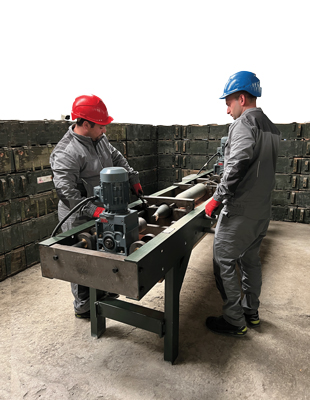
Unserviceable and obsolete ammunition is destroyed in Georgia. Courtesy of ITF Enhancing Human Security.
Georgia inherited large stockpiles of deteriorating Soviet munitions that are now more than 30 years old. It is also impacted by explosive hazards from the conflicts in its South Ossetia (1988–1992) and Abkhazia (1992–1993) regions, and the 2008 conflict with Russia.
From FY98 to FY23, the United States provided more than $56 million to Georgia for the safe clearance of mines and unexploded ordnance, destruction of excess and aging conventional weapons and ammunition, and capacity building assistance to help Georgia address future hazards.
In FY23, the Department of State supported:
- The Ministry of Defense’s continued efforts to destroy unserviceable and obsolete ammunition, improve the storage conditions of ammunition prior to disposal, and strengthen security at ammunition storage facilities.
With funding from the Department of Defense:
- Ammunition subject-matter experts from the (U.S.) Georgia National Guard taught a course on International Ammunition Technical Guidelines with the Georgian Ministry of Defense general staff. This course is the second training event in a three-year process.
- U.S. European Command continued upgrades to the Vartsikhe and Vazini munitions central storage facility with security fencing, equipment, and on-the-job training on how to safely transport, store, and inspect munitions. U.S. European Command also provided technical assistance to the Ministries of Defense and Interior on development of National Regulations on Ammunition and Explosive Safety.
- U.S. European Command, the Navy Surface Warfare Center Explosive Ordnance Disposal Technical Center, the Humanitarian Demining Training Center, and U.S. National Guard experts completed a site assessment that researched unique ordnance in Georgia that will be the backbone of an International Mine Action Standard explosive ordnance disposal Level 3+ Technical Analysis Course.
- With global funding from USAID, the Leahy War Victims Fund supported Results for Development, Momentum Wheels for Humanity, and the World Health Organization to integrate and strengthen rehabilitation services in existing healthcare systems.
|
Source |
FY98–20 |
FY21 |
FY22 |
FY23 |
TOTAL |
|
DOS NADR-CWD |
$31,405 |
$0 |
$2,000 |
$2,000 |
$35,405 |
|
DOS Other |
$2,644 |
$0 |
$0 |
$0 |
$2,644 |
|
DoD |
$4,596 |
$1,980 |
$3,875 |
$3,295 |
$13,746 |
|
USAID |
$4,500 |
$0 |
$0 |
$0 |
$4,500 |
|
Country Total |
$43,145 |
$1,980 |
$5,875 |
$5,295 |
$56,295 |
(Dollars in thousands)
FY23 Georgia key performance metrics:
- 228.93 Metric tons of unserviceable ammunition destroyed
- 7 Armories built or rehabilitated
- Golden West Humanitarian Foundation, ITF Enhancing Human Security, Results for Development, Momentum Wheels for Humanity, World Health Organization
Kosovo
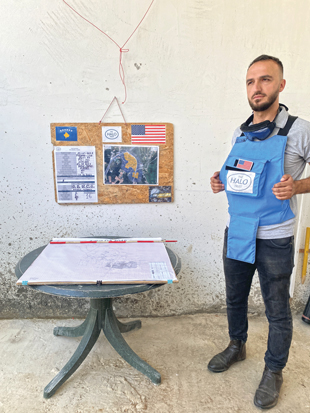
A U.S.-funded deminer in Kosovo displays clearance plans. Courtesy of The HALO Trust.
Unexploded ordnance contamination continues to threaten human security and limit economic development in Kosovo. What remains is primarily from the conflict between the Federal Republic of Yugoslavia and the Kosovo Liberation Army in the late 1990s, and later from NATO air strikes during the 1999 Kosovo conflict. As of September 2023, the Kosovo Mine Action Center reported 9.9 million square meters (2,446 acres) of land still contaminated by explosive hazards spread across 69 sites.
From FY96 to FY23, the United States provided more than $46 million in assistance to Kosovo for survey and clearance.
In FY23 (with prior year funds), the Department of State supported:
- Survey and clearance to return land to the local population for safe and productive use.
With funding from the Department of Defense:
- The Humanitarian Demining Research and Development Program partnered with The HALO Trust to continue deployment of handheld standoff dual-head mine detectors, the Scorpion unexploded ordnance detection system, and newly deployed commercial detectors Vallon VMH4 metal detector and VX-1 magnetometer. These technologies have cleared over 520,000 square meters (128 acres) of land and removed approximately 50 mines since 2016.
- U.S. Air Forces in Europe completed an International Mine Action Standard explosive ordnance disposal Level 3 Phase III train-the-trainer curriculum customized by Kosovo Security Forces explosive ordnance disposal.
- U.S. European Command provided a physical security and stockpile management foundation course in Tirana, Albania.
- Ammunition experts from the Iowa National Guard and Golden West Humanitarian Foundation conducted an assessment of the current Kosovo Security Forces ammunition storage plan highlighting unanticipated planning considerations that must be addressed before national funds are expended.
|
Source |
FY96–20 |
FY21 |
FY22 |
FY23 |
TOTAL |
|
DOS NADR-CWD |
$19,725 |
$1,000 |
$800 |
$0 |
$21,525 |
|
DoD |
$5,471 |
$497 |
$720 |
$1,092 |
$7,780 |
|
USAID |
$17,472 |
$0 |
$0 |
$0 |
$17,472 |
|
Country Total |
$42,668 |
$1,497 |
$1,520 |
$1,092 |
$46,777 |
(Dollars in thousands)
FY23 Kosovo key performance metrics:
- 441,470 Sq m (109 acres) of land cleared
- 161 Explosive remnants of war destroyed
- Golden West Humanitarian Foundation. The HALO Trust, Norwegian People’s Aid
Serbia
Serbia’s unexploded ordnance is the result of the Yugoslav Wars of 1991–2001 and NATO air strikes during the 1999 Kosovo conflict. Landmines also persist along Serbia’s border with Kosovo. As of September 2023, the Serbia Mine Action Center reported more than 1 million square meters (247 acres) of land remain as either confirmed or suspected hazardous areas. The large stockpiles of obsolete ammunition inherited from the former Yugoslav National Army also pose a significant risk of illicit proliferation and accidental explosions.
From FY07 to FY23, the United States invested more than $27 million in Serbia to destroy small arms, light weapons, and ammunition, and clear explosive hazards.
In FY23 the Department of State supported:
- Survey and clearance operations to remediate the impact of explosive hazards.
- Safety and security enhancements to the Ministry of Interior’s Duvanište small arms storage site.
With funding from the Department of Defense, U.S. Air Forces in Europe conducted an International Mine Action Standards explosive ordnance disposal Phase 2 Level 1 train-the-trainer event.
|
Source |
FY07–20 |
FY21 |
FY22 |
FY23 |
TOTAL |
|
DOS NADR-CWD |
$23,230 |
$1,000 |
$1,000 |
$1,000 |
$26,230 |
|
DoD |
$310 |
$294 |
$430 |
$140 |
$1,174 |
|
Total |
$23,540 |
$1,294 |
$1,430 |
$1,140 |
$27,404 |
(Dollars in thousands)
FY23 Serbia key performance metrics:
- 445,519 Sq m (110 acres) of land cleared
- 20 Explosive remnants of war destroyed
- ITF Enhancing Human Security, United Nations Development Programme-South Eastern Europe Clearing House for the Control of Small Arms and Light Weapons2
Slovakia
U.S. conventional weapons destruction assistance plays a key role in helping Slovakia’s Ministry of Defense reduce stockpiles of unserviceable ammunition.
From FY20 to FY23, the United States invested $1 million in Slovakia to destroy unserviceable ammunition.
In FY23 (with prior year funds) the Department of State supported:
- The reduction of national stockpiles of unserviceable ammunition.
|
Source |
FY20 |
FY21 |
FY22 |
FY23 |
TOTAL |
|
DOS NADR-CWD |
$1,000 |
$0 |
$0 |
$0 |
$1,000 |
|
Total |
$1,000 |
$0 |
$0 |
$0 |
$1,000 |
(Dollars in thousands)
FY23 Slovakia key performance metrics:
- 201.6 Metric tons of unserviceable ammunitions destroyed
- NATO Support and Procurement Agency
Ukraine
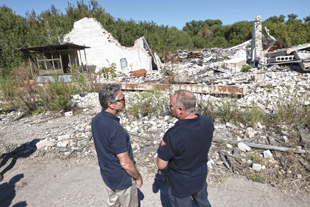
Secretary of State Antony Blinken visits U.S.-funded deminers for the Fondation suisse de déminage in Chernihiv oblast, Ukraine, in September 2023. Courtesy of Department of State.
Russia’s illegal full-scale invasion in February 2022 has intentionally littered massive swaths of Ukraine with landmines, unexploded ordnance, and improvised explosive devices, which block access to farmland, impede recovery efforts, prevent displaced families from returning to their homes, and continue to kill and maim innocent Ukrainian civilians. As of September 2023, the Government of Ukraine estimated that 174,000 square kilometers (42,996,336 acres) of its territory may have explosive hazards—this is an area larger than the state of Illinois. This includes 25,000 square kilometers (6,177,635 acres) of farmland, which feeds approximately 81 million people globally. Russia’s brutal invasion is thus worsening the global food crisis.
From FY04 to FY23, the United States invested more than $263.5 million in Ukraine for humanitarian mine action and to help the Ministry of Defense safely manage its ammunition stockpiles. This includes $27.4 million provided after Russia’s initial invasion of Ukraine in 2014 to support survey and clearance operations along what was then the heavily mined line of contact in Donetsk and Luhansk Oblasts and provide capacity-building assistance to Ukraine’s demining authorities. This also includes $182 million in regularly budgeted and supplemental FY23 funding as well as prior year funding committed since February 2022 to address the explosive hazard contamination from Russia’s ongoing war of aggression.
In FY23, the Department of State’s conventional weapons destruction program supported:
- Survey and clearance of suspected and confirmed hazardous areas.
- Digital and in-person explosive ordnance risk education for at-risk civilians.
- Training and equipment for Government of Ukraine demining and explosive ordnance disposal operators to international standards.
- Established a state-of-the-art training facility in Ukraine.
- Capacity-building assistance at a strategic level for Ukraine’s demining authorities.
This assistance has helped the Government of Ukraine to train and coordinate its own teams, while also overseeing the rapidly expanding humanitarian mine action assistance provided by the United States and the international community. The Department of State’s Office of Weapons Removal and Abatement and its Interagency MANPADS Task Force also coordinates U.S. and Allied efforts to bolster the accountability of weapons storage in Ukraine and neighboring states as part of broader U.S. efforts to mitigate potential conventional weapons diversion. In FY23, the Interagency MANPADS Task Force collaborated with allies and partners (including France, Germany, United Kingdom, European Union, and others) to reduce the risk of illicit trafficking of certain advanced conventional weapons by providing nearly 50 Ukrainian border guards with MANPADS and anti-tank guided missile recognition training.
Through its Ukraine Rapid Response Fund, the Department of State’s Bureau of Conflict and Stabilization Operations initiated a project to support victims of missile and drone strikes, landmines, and other conflict-related events, including physical and psychological rehabilitation.
The Department of State’s Bureau of International Narcotics and Law Enforcement Affairs provided vehicles, metal detectors, bomb suits, explosive ordnance disposal equipment, and extensive training to enhance the National Police of Ukraine’s emergency response capacity.
With funding from the Department of Defense:
- The Humanitarian Demining Research and Development Program deployed three Scorpion unexploded ordnance detection systems and the Spot robot to Ukraine. The Spot will be evaluated for its suitability as a reconnaissance platform to move among rubble and move small, unexploded ordnance items. The HALO Trust continued to evaluate the Harrow magnet system and the Traxx remote vegetation clearance system in the western part of the country. Program technologies have cleared over 570,000 square meters (141 acres) of land to date.
- U.S. European Command is working with the Department of State and international partners to coordinate equipment and training to Ukrainian State Emergency Services and National Police of Ukraine forces.
USAID direct funding supported:
- Explosive ordnance risk education through the development of an animated series Adventures of Patron, the famous bomb-sniffing dog and mascot of the State Emergency Service of Ukraine.
- Contribution to the multi-donor Partnership Fund for a Resilient Ukraine for training and equipment for deminers in the State Emergency Service.
- Salary support for more than 57,300 first responders in the State Emergency Service.
As part of its global programs, USAID’s Leahy War Victims Fund supported Johns Hopkins University-Bloomberg School of Public Health, Wheels for Humanity, and the World Health Organization to develop health systems responsive to the need for rehabilitation, strengthen the delivery of rehabilitation services, and integrate rehabilitation services in existing healthcare systems.
|
Source |
FY04–20 |
FY21 |
FY22 |
FY23 |
TOTAL |
|
DOS NADR-CWD |
$57,067 |
$10,397 |
$71,000 |
$90,000 |
$228,464 |
|
DOS Other |
$1,155 |
$2,684 |
*$18,690 |
$0 |
$22,529 |
|
DoD |
$7,090 |
$717 |
$786 |
$22 |
$8,615 |
|
USAID |
$3,957 |
$0 |
$0 |
$0 |
$3,957 |
|
Total |
$69,269 |
$13,798 |
$90,476 |
$90,022 |
$263,565 |
(Dollars in thousands) *Funds have been adjusted to reflect actual funding levels for FY22.
FY23 Ukraine Key performance metrics:
- 838,687 Sq m (207 acres) of land cleared
- 450 Explosive ordnance disposal call-outs
- 500 Landmines destroyed
- 1,472 Explosive remnants of war destroyed
- 140,053 Explosive ordnance risk education recipients
- Danish Refugee Council, Geneva International Centre for Humanitarian Demining, The HALO Trust, Johns Hopkins University-Bloomberg School of Public Health, Momentum for Humanity, NATO Support and Procurement Agency, Organization for Security and Co-operation in Europe, Spirit of Soccer, Fondation suisse de déminage, Tetra Tech, Wheels for Humanity, World Health Organization
Regional Programs
South Caucasus Regional Program: In FY23 the Department of State provided $2.28 million for humanitarian demining operations in areas affected by the Nagorno-Karabakh conflict. Explosive hazards across the conflict-affected area continue to kill and maim civilians, block economic development, and impede the safe return of displaced families. Since the November 9, 2020 trilateral arrangement, more than 360 people have been killed or injured in landmine accidents in the region. The Department of State’s FY23 funding built on the $2.5 million previously provided and further strengthened the technical capacity of demining organizations to clear explosive hazards in line with international standards.
Since FY99, the United States has provided more than $52.1 million to support clearance operations in the conflict-affected area, provided explosive ordnance risk education, assisted landmine survivors, and strengthened the capacity of demining organizations.
In FY23, the Department of State’s conventional weapons destruction program supported:
- Survey and clearance of landmines and other explosive hazards.
- Explosive ordnance risk education for at-risk civilians.
- Capacity development for a national mine action authority and nongovernmental organization partner.
With funding from the Department of Defense, the Humanitarian Demining Research and Development Program made preparations to deploy the Prime Tech PT300 mine neutralization system to the Azerbaijan National Agency for Mine Action in early FY24.
FY23 Regional programs key performance metrics:
- 746,951 Sq m (184 acres) of land cleared
- 101 Explosive ordnance disposal call-outs
- 4 Landmines destroyed
- 921 Explosive remnants of war destroyed
- 6,539 Explosive ordnance risk education recipients
- The HALO Trust, MAG (Mines Advisory Group)
Other U.S. Support
With global funding from USAID, the Leahy War Victims Fund supported the World Health Organization to integrate rehabilitation in existing healthcare systems in Armenia, Azerbaijan, and Moldova.
With funding from the Department of Defense, the United States provided support for conventional weapons destruction in the following countries:
- Estonia: U.S. European Command supported military diver and underwater explosive ordnance training and database training.
- Moldova: The U.S. Army Europe continued to renovate ammunition storage facilities in Floresti and Cahul. The upgrades consist of security fencing, renovation of three explosive storehouses, ramp replacements, floor refurbishment, and depot emergency water supply. U.S. Army Europe assisted Moldovan government personnel with updating their national regulations for international best practices in humanitarian mine action, and completed an International Mine Action Standard explosive ordnance disposal Level 2 Phase I train-the-trainer curriculum with Moldovan Ministry of Defense. In addition, ammunition subject-matter experts from the U.S. Air Forces in Europe completed an International Ammunition Technical Guidelines compliant physical security stockpile management foundation management course with the Moldovan Ministry of Defense.
- North Macedonia: The Vermont National Guard conducted train-the-trainer courses on International Mine Action Standards explosive ordnance disposal Level 2 Phase 2.
Introduction
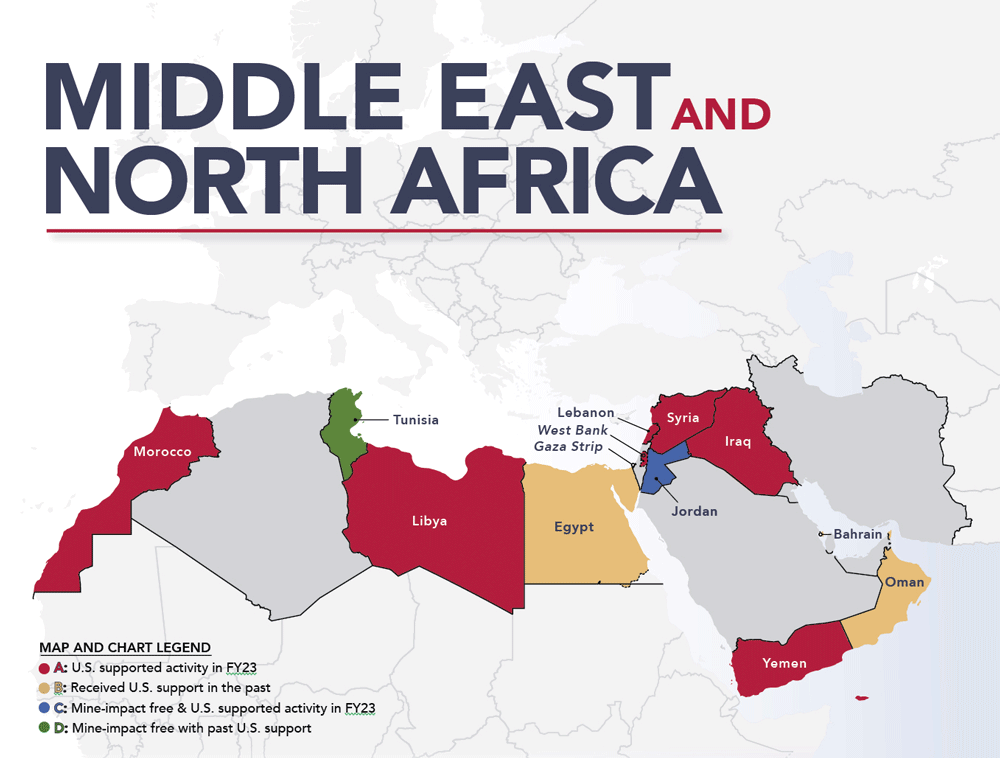
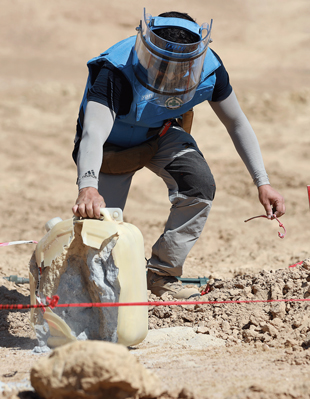
The remains of an IED are excavated in Iraq. Courtesy of Norwegian People’s Aid.
Since 1993, the United States has invested over $1 billion in conventional weapons destruction assistance in the Middle East and North Africa to enhance stability and improve human security. Since 1993, the United States has invested over $1 billion in conventional weapons destruction assistance in the Middle East and North Africa to enhance stability and improve human security. Improvised explosive devices, landmines, and explosive remnants of war emplaced by the Islamic State in Iraq and Syria (ISIS) further threatened the lives of displaced families returning to their homes, and impeded reconstruction efforts and local economic development in Iraq, Lebanon, Libya, and Syria. In Libya, explosive hazard contamination and the harvesting of explosives for improvised explosive devices endangers civilians, fuels instability, and continues to displace civilians. In Yemen, the ongoing conflict is producing significant quantities of explosive remnants of war, and the massive use of landmines and improvised explosive devices there continue to kill civilians and impede the safe delivery of urgent humanitarian assistance.
According to the 2023 Cluster Munition Monitor and the 2022 Landmine Monitor, three of the six countries with the highest number of civilian casualties from landmines and explosive remnants of war are in the Middle East—Iraq, Syria, and Yemen—due in large part to the ongoing conflicts in these countries. Unfortunately, the number of casualties caused by explosive remnants of war increased in Iraq and Yemen in 2022.
Across Lebanon, U.S. investments in survey and clearance are contributing to improved food security as contaminated land is made safe and returned to landowners for cultivation and grazing. With the country in economic crisis and demand for locally grown food increasing, every square meter of arable land holds potential for investment. On the fertile land of the western slopes of Jabal Al Barouk in the Chouf region, Lebanese farmers have regained access to land that was contaminated in the civil war. It has now been transformed into plots with apples, pomegranates, oranges, grapes, and olives grown and sold at local markets.
U.S. investment has also established professional national mine action centers and built strong and capable host country capacities across the Middle East. Meanwhile, explosive ordnance risk education reduced deaths and injuries, and survivor assistance projects provided rehabilitation and reintegration support. Altogether, these programs lay the groundwork for stability and prosperity across the region.
FY23 cumulative performance metrics in the Middle East and North Africa (Metrics include total U.S. assistance across the region, not just key metrics from featured countries)
- 20,691,279 Sq m (5,113 acres) of land cleared
- 5,109 Landmines destroyed
- 905 Explosive ordnance disposal call-outs
- 1,080,693 Risk education recipients
- 62,905 Explosive remnants of war destroyed
- 1,312 Survivor assistance recipients
Allocation of $63.52 million to the Middle East and North Africa in FY23 by country (dollars in thousands)
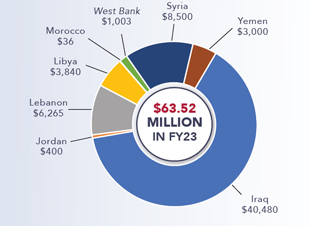
Top five countries funded in the Middle East and North Africa FY93-FY23 (dollars in thousands)
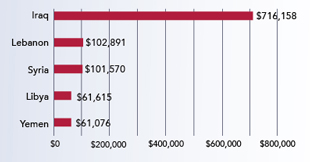
|
|
Country/Region |
FY93-20 |
FY21 |
FY22 |
FY23 |
Total |
|
B |
Bahrain |
$10 |
$0 |
$0 |
$0 |
$10 |
|
B |
Egypt |
$718 |
$0 |
$0 |
$0 |
$718 |
|
A |
Iraq |
$597,145 |
$38,280 |
$40,253 |
$40,480 |
$716,158 |
|
C |
Jordan |
$29,322 |
$400 |
$400 |
$400 |
$30,522 |
|
A |
Lebanon |
$82,217 |
$8,324 |
$6,085 |
$6,265 |
$102,891 |
|
A |
Libya |
$51,575 |
$2,000 |
$4,200 |
$3,840 |
$61,615 |
|
A |
Morocco |
$678 |
$164 |
$1,154 |
$36 |
$2,032 |
|
B |
Oman |
$4,338 |
$0 |
$0 |
$0 |
$4,338 |
|
A |
Syria |
$86,070 |
$0 |
$7,000 |
$8,500 |
$101,570 |
|
D |
Tunisia |
$1,383 |
$0 |
$0 |
$0 |
$1,383 |
|
A |
West Bank and |
$6,368 |
$1,013 |
$1,014 |
$1,003 |
$9,398 |
|
A |
Yemen |
$49,201 |
$4,000 |
$4,875 |
$3,000 |
$61,076 |
|
|
Regional |
$935 |
$0 |
$0 |
$0 |
$935 |
|
|
Total |
$909,960 |
$54,181 |
$64,981 |
$63,524 |
$1,092,646 |
- In FY23 the United States did not fund conventional weapons destruction programs in the Gaza Strip.
CHART LEGEND
A: U.S. supported activity in FY23
B: Received U.S. support in the past
C: Mine-impact free & U.S. supported activity in FY23
D: Mine-impact free with past U.S. support
Clearing ISIS’s deadly legacy from Mosul’s Old City: Saving the past for a safe future
Article and photos courtesy of Tetra Tech
Mosul, an ancient city established in the 7th Century BC and the second largest in Iraq, is a warren of narrow stone streets lined with historic buildings—and littered with webs of steel rebar, piles of rubble, and shards of broken glass left after fierce battles to expel Islamic State of Iraq and Syria (ISIS) terrorists. Now, a veil of dust powders the area while the hum of a motorbike, the mechanical clank of an excavator, and a splash along the riverbank fade against the rising call of the “adhan” (call to prayer).
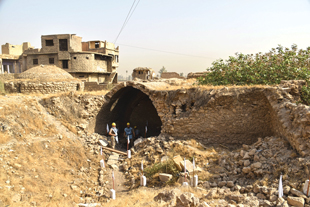
Castle bathhouse in Old Mosul is cleared of explosive hazards.
In June 2014, ISIS terrorists took Mosul by force and occupied the Old City. More than 500,000 civilians fled. Thousands more were murdered by ISIS. During their three-year occupation, ISIS cut tunnels through ancient heritage sites and booby-trapped homes with improvised explosive devices.
Liberation came at a heavy cost to Mosul the Old City, as Iraqi and Coalition airstrikes against dug-in ISIS terrorists reduced homes and ancient buildings to piles of rubble during the eight-month-long Battle for Mosul. Meanwhile, ISIS militants spread thousands of notoriously deadly, difficult to detect, and cheap to produce improvised explosive devices across the city. Many of these “hidden killers” remain scattered beneath the rubble.
Despite the conflict, Old Mosul’s cultural roots run deep. To help displaced families return to this historic quarter, the U.S. Department of State’s Office of Weapons Removal and Abatement and donor nations, guided by the Iraq Directorate of Mine Action, partnered with Tetra Tech, a Texas-based global company, to clear explosive hazards from critical infrastructure in Mosul and across Iraq.
Since 2019, Tetra Tech has cleared and released 578,000 square meters (143 acres) of land in Old Mosul alone, including the historic Castle Bathhouse. Built in 1879, the compound is situated on the banks of the Tigris River and preserves several delicately arched subterranean brick vaults where woodburning fires once heated water into steam for bathers.
“It was a wonderful place,” said Hassan, an Iraqi liaison officer working with Tetra Tech to clear explosive hazards from his hometown. Sharing fond memories of the bathhouse, Hassan recalls visits alongside his father and grandfather as a young boy. “This bath was only used by men. The women had a separate bathhouse in Al Furaq, also in Old Mosul, which my grandmother visited.”
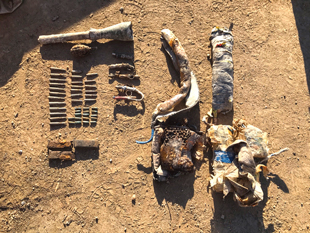
Clearance of historic structures like the Castle Bathhouse helps advance long-term recovery from conflict. Tetra Tech removed 31 explosive hazards from the Castle Bath complex alone. Now, the Iraqi State Board of Antiquities and Heritage and the United Nations Educational, Scientific, and Cultural Organization (UNESCO) are restoring the site as a museum and heritage center.
The assistance of the United States and other donor nations is vital to safeguarding peace, prosperity, and cultural heritage across Iraq. The bathhouse is one of four historic Old Moslawi landmarks Tetra Tech has cleared in coordination with local authorities and international partners. To date, Tetra Tech’s ongoing clearance has removed 472,000 metric tons of rubble from Old Mosul, and rendered-safe 3,500 explosive hazards, including 675 improvised explosive devices. Ultimately, this crucial work allows families to return home safely, rebuild the local economy, and revitalize their beloved community they once feared lost forever.
Iraq
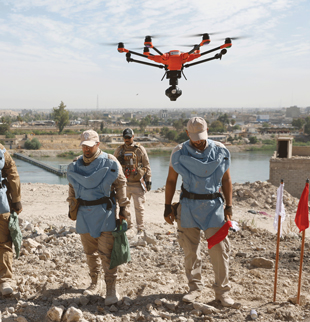
Tetra Tech uses drones to keep demining team members safe during battle area clearance in Old Mosul. Courtesy of Tetra Tech.
During its brutal control of large swaths of northern and western Iraq, ISIS planted an unprecedented level of mass-produced, technologically sophisticated, improvised explosive devices and other explosive hazards to kill civilians, discourage the return of displaced communities, block economic development, and hinder stabilization. Since 2015, the United States and other international donors, in partnership with the Iraqi government, have made significant progress in clearing improvised explosive devices emplaced by ISIS, but much work remains. The United States remains dedicated to the survey and clearance of these explosive hazards and to delivering explosive ordnance risk education to help prevent injuries. The clearance of areas liberated from ISIS remains a priority for the United States, including the ancestral homelands of Iraq’s ethnic and religious minority communities in Ninewa Governorate, even as the United States continues long-standing support for the survey and clearance of legacy hazards in northern and southern Iraq and capacity-building assistance to Iraq’s Directorate of Mine Action and the Iraqi Kurdistan Mine Action Authority.
The United States remains the largest international supporter of humanitarian mine action in Iraq investing more than $716 million from FY03 to FY23 to support marking, survey, and clearance as well as explosive ordnance risk education.
In FY23, the Department of State supported:
- Survey and clearance in areas liberated from ISIS in Anbar, Kirkuk, Ninewa, and Salah Al-Din Governorates. This work helped displaced Iraqis—including members of Christian, Yezidi, Shabak, Kaka’i, and Turkmen minority communities—safely return home and begin rebuilding their lives and local economies.
- Clearance of legacy explosive hazards in Kurdistan and U.S.-origin unexploded ordnance in southern Iraq.
- Strengthening of the Iraqi Directorate of Mine Action’s capacity to conduct strategic planning and operational coordination as well as information management associated with humanitarian mine action operations across Iraq.
- Virtual and in-person explosive ordnance risk education for at-risk communities across Iraq that taught both children and adults about the dangers of explosive hazards.
The Department of Defense Humanitarian Demining Research and Development program continued to partner with MAG (Mines Advisory Group) to deploy the Wirehound handheld detector, a stand-alone orbital sifter, and the Rebel Crusher sifter/rock crushing plant with multiple commercial front-loader attachments. This effort cleared over 2,000 mines and unexploded ordnance from more than 290,000 cubic meters (10 million cubic feet) of soil to date. In partnership with The HALO Trust, the Wirehound handheld detector, the Rambo demining support vehicle, and the Wet Soil Sifting Bucket is also being evaluated.
|
Source |
FY03-20 |
FY21 |
FY22 |
FY23 |
TOTAL |
|
DOS NADR-CWD |
$490,151 |
$38,150 |
$40,000 |
$40,000 |
$608,301 |
|
DOS Other |
$992 |
$0 |
$0 |
$0 |
$992 |
|
CDC |
$450 |
$0 |
$0 |
$0 |
$450 |
|
DoD |
$105,552 |
$130 |
$253 |
$480 |
$106,415 |
|
Total |
$597,145 |
$38,280 |
$40,253 |
$40,480 |
$716,158 |
(dollars in thousands)
FY23 Iraq key performance metrics:
- 16,477,294 Sq m (4,072 acres) of land returned to communities
- 466 Explosive ordnance disposal call-outs
- 748 Landmines destroyed
- 12,508 Explosive remnants of war destroyed
- 2,938 IED or components cleared or destroyed
- 119,327 Explosive ordnance risk education recipients
- Implementing partners: Danish Refugee Council, The HALO Trust, iMMAP, MAG (Mines Advisory Group), Norwegian People’s Aid, Spirit of Soccer, Fondation suisse de déminage, Tetra Tech
Jordan
Jordan declared itself mine-free in 2012, having made significant progress to reduce the threat of landmines and explosive remnants of war from the 1948 conflict following the partition of Palestine, the 1967 Arab-Israeli conflict, and its 1970 civil war.
From FY96 to FY23, the United States invested more than $30 million in Jordan to clear mines and explosive remnants of war, destroy old and obsolete ammunition, deliver explosive ordnance risk education, and provide rehabilitation and reintegration support to survivors of landmine and unexploded ordnance accidents.
In FY23, Department of State supported:
- Rehabilitative care, vocational training, and prosthetics for Jordanians and Syrian refugees who are survivors of landmine and unexploded ordnance accidents.
|
Source |
FY96-20 |
FY21 |
FY22 |
FY23 |
TOTAL |
|
DOS NADR-CWD |
$23,636 |
$400 |
$400 |
$400 |
$24,836 |
|
DOS Other |
$300 |
$0 |
$0 |
$0 |
$300 |
|
CDC |
$2,968 |
$0 |
$0 |
$0 |
$2,968 |
|
DoD |
$2,418 |
$0 |
$0 |
$0 |
$2,418 |
|
Total |
$29,322 |
$400 |
$400 |
$400 |
$30,522 |
(dollars in thousands)
FY23 Jordan key performance metrics:
- 1,142 Survivor assistance recipients
- Implementing partner: POLUS Center for Social and Economic Development
Lebanon
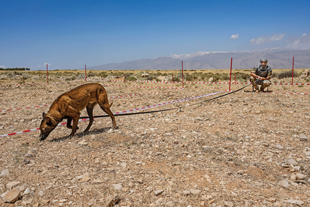
A Lebanon Armed Forces soldier works with a mine detection dog. Courtesy of ITF Enhancing Human Security.
Lebanon has significant landmine and explosive remnants of war contamination from its 1975–1990 civil war, the laying of minefields along the Blue Line between 1984–2000, and the Israel-Hezbollah conflict of 2006. Additionally, ISIS and other terrorist groups seeded fertile land along Lebanon’s northeast border with Syria with landmines and improvised explosive devices in 2017 before the Lebanon Armed Forces dislodged them. Over 26.7 million square meters (7,809 acres) of land has suspected or confirmed explosive hazard contamination according to the Lebanon Mine Action Center’s 2022 annual report. U.S. assistance cleared the last landmines in and around Lebanon’s famed cedar forests in the Northern Governorate in 2021 and built on this achievement by funding the complete clearance of the northeast border region in 2023. Ceremonies attended by the U.S. Ambassador, the Commander of the Armed Forces of Lebanon General Aoun, other donor countries, and the communities impacted, enabled the Lebanon Mine Action Center to officially declare these areas free from the impact of explosive hazards and turn them back over to local communities for productive use. The United States continues to support the Lebanon Armed Forces’ capacity to store and manage ammunition safely, with major physical upgrades to its facilities including breaking ground on a regional depot for the Lebanese Armed Forces in the Bekaa, as well as storekeeper training.
From FY98 to FY23, the United States invested more than $102 million in Lebanon to survey and clear landmines and explosive remnants of war, procure and train mine detection dogs, provide explosive ordnance risk education, build the capacity of the Lebanon Mine Action Center, and provide medical assistance and vocational training for landmine survivors. The United States is Lebanon’s largest international provider of demining and other conventional weapons destruction assistance, which has significantly strengthened the Lebanese Armed Forces’ capacity to manage its arms and ammunition stockpiles.
In FY23, the Department of State supported:
- Survey and clearance of explosive hazards in South and Nabatieh Governorates, as well as northeast Lebanon, to provide access for livestock and agricultural development.
- Clearance of explosive hazards from the 2006 Israel-Hezbollah conflict and the 1975–1990 civil war in Mount Lebanon Governorate to facilitate the return of displaced residents and boost economic development for communities in the Aley, Baabda, and Chouf Districts.
- Capacity development for the Lebanese Mine Action Center, a component of the Lebanese Armed Forces, by providing solar power to its headquarters in Beirut, new vehicles, repairs to vehicles that had fallen out of service, and international training to its staff to build their professional skills.
- Completing construction of new munitions storage warehouses at four Lebanese Armed Forces bases.
The Department of Defense Humanitarian Demining Research and Development Program partnered with MAG (Mines Advisory Group) to continue evaluation of soil excavation, sifting, and grinding attachments for its armored excavators as well as the Terrapin small remote excavator. Since 2011, these technologies have been used to clear over 17,000 mines and unexploded ordnance from approximately 330,000 square meters (82 acres) of land.
|
Source |
FY98-20 |
FY22 |
FY22 |
FY23 |
TOTAL |
|
DOS NADR-CWD |
$60,999 |
$8,000 |
$6,000 |
$6,000 |
$80,999 |
|
DOS Other |
$2,000 |
$0 |
$0 |
$0 |
$2,000 |
|
DoD |
$9,368 |
$324 |
$85 |
$265 |
$10,042 |
|
USAID |
$9,850 |
$0 |
$0 |
$0 |
$9,850 |
|
Total |
$82,217 |
$8,324 |
$6,085 |
$6,265 |
$102,891 |
(dollars in thousands)
FY23 Lebanon key performance metrics:
- 196,538 Sq m (49 acres) of land cleared
- 2,211 Landmines destroyed
- 130 Explosive remnants of war destroyed
- 2,581 Explosive ordnance risk education recipients
- 13 Personnel trained in stockpile management
- Implementing partners: DanChurchAid, ITF Enhancing Human Security, MAG (Mines Advisory Group)
Libya
The full extent of landmine contamination, improvised explosive devices, and explosive remnants of war in Libya remains unknown due to the limited control the internationally recognized Government of National Unity has over Libya and continuing insecurity in some parts of the country in the wake of the 2011 revolution, and ISIS control of the area around Sirte in 2015. Additionally, during renewed fighting around Tripoli in 2019-2020, Russian-backed Wagner Group forces placing landmines and boobytraps while retreating from the outskirts of Tripoli. Illicit small arms proliferation remains a concern and fuels conflict in neighboring states and across the Sahel. The United States works with allies, international organizations, and implementing partners to mitigate these threats, which hinder development, limit the reach of humanitarian assistance, and threaten the safety of displaced Libyans who seek to return to their homes and communities.
From FY11 to FY23, the United States invested more than $61 million to help its partners and allies clear explosive remnants of war, respond to emergency callouts, and provide explosive ordnance education.
In FY23, the Department of State supported:
- The survey and clearance of battlefields around Tripoli, Sirte, Benghazi, and Misrata, and responded to emergency callouts.
- Clearance of improvised explosive devices and landmines placed by Wagner Group forces in the Tripoli area.
- Immediate response to provide explosive ordnance risk education as well as callouts to destroy explosive hazards left behind from the clashes in Tripoli in August 2023, and to support the Libya Mine Action Center’s development of standard operating procedures, national standards, and increased capacity.
The Department of Defense Humanitarian Demining Research and Development Program partnered with The HALO Trust to evaluate the suitability of a Bearcat area preparation system, four commercial handheld detectors, and excavator attachments to clear hidden victim-activated devices in buildings and rubble left by insurgents to make it safe for returning refugees.
|
Source |
FY11-20 |
FY21 |
FY22 |
FY23 |
TOTAL |
|
DOS NADR-CWD |
$32,000 |
$2,000 |
$4,200 |
$3,500 |
$41,700 |
|
DOS Other |
$19,575 |
$0 |
$0 |
$0 |
$19,575 |
|
DoD |
$0 |
$0 |
$0 |
$340 |
$340 |
|
Total |
$51,575 |
$2,000 |
$4,200 |
$3,840 |
$61,615 |
(dollars in thousands)
FY23 Libya key performance metrics:
- 53,077 Sq m (13 acres) of land cleared
- 274 Explosive ordnance disposal call-outs
- 2,085 Explosive remnants of war destroyed
- 52.49 Metric tons of unserviceable ammunition destroyed
- Implementing partners: DanChurchAid, Free Fields Foundation, The HALO Trust, ITF Enhancing Human Security
Syria
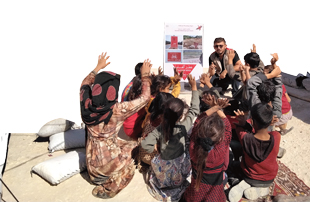
Children in Syria learn about the dangers of explosive hazards. Courtesy of MAG (Mines Advisory Group).
The Syrian civil war (2011–present) and rise of ISIS led to massive contamination from explosive remnants of war, improvised explosive devices, landmines, and booby-traps across the country. ISIS planted large numbers of explosive hazards specifically to target civilians, deny access to farmland and critical infrastructure, and perpetuate their terror campaign. Humanitarian mine action plays a critical role in establishing security and humanitarian access in areas liberated from ISIS, which in turn enables stabilization activities such as the restoration of water, electricity, healthcare, schools, and bakeries. Faced with a lack of local mine action capacity at the start of the campaign to defeat ISIS in areas of northeast Syria not held by the Syrian regime, the United States and other donors had to rely on foreign companies and nongovernmental organizations to survey, mark, and clear explosive hazards, as well as to train Syrians to start building local demining capacity.
From 2013 to 2023, the Department of State contributed more than $101 million to humanitarian mine action efforts in non-regime held northeast Syria, as well as programmed several international donor contributions through the U.S. CWD program.
In FY23, the Department of State supported:
- Survey, marking, and clearance of areas in northeast Syria contaminated with explosive hazards, as well as training for Syrians to build a local humanitarian mine action capacity.
- Delivery of explosive ordnance risk education to affected communities in northeast Syria.
|
Source |
FY13-20 |
FY21 |
FY22 |
FY23 |
TOTAL |
|
DOS NADR-CWD |
$86,060 |
$0 |
$7,000 |
$8,500 |
$101,560 |
|
DoS |
$10 |
$0 |
$0 |
$0 |
$10 |
|
Total |
$86,070 |
$0 |
$7,000 |
$8,500 |
$101,570 |
(dollars in thousands)
FY23 Syria key performance metrics:
- 707,903 Sq m (175 acres) of land cleared
- 45 Explosive ordnance disposal call-outs
- 143 Explosive remnants of war destroyed
- 66 IED or components cleared or destroyed
- 12,193 Explosive ordnance risk education recipients
- Implementing partners: iMMAP, MAG (Mines Advisory Group)
West Bank/Gaza Strip
The West Bank has landmines and unexploded ordnance from the decades of conflict beginning in 1948. Jordan laid 13 minefields from 1948 to 1967, and Israel laid 77 more after the 1967 war. Israel Defense Force training exercises in parts of the West Bank have produced additional unexploded ordnance, which is often discovered by local herders and farmers.
From FY11 to FY23, the United States invested more than $9.3 million to survey and clear landmines and unexploded ordnance from privately owned land that is not subject to disputes between Palestinians and Israelis. This decade-long effort by the United States is the only one of its kind in the West Bank.
In FY23, Department of State supported:
- Clearance of minefields and quality control and quality assurance activities in the West Bank.
The Department of Defense Humanitarian Demining Research and Development Program partnered with The HALO Trust to evaluate the Ferex 4.034 and Magnex magnetometer detection systems, a Target Reacquisition and Positioning System that can map humanitarian demining tasks, and the Kompaq Screener. These technologies have cleared over 500 mines from approximately 210,000 square-meters (52 acres) of land in the West Bank since 2018.
|
Source |
FY11-20 |
FY21 |
FY22 |
FY23 |
TOTAL |
|
DOS NADR-CWD |
$6,088 |
$1,000 |
$1,000 |
$1,000 |
$9,088 |
|
DoD |
$280 |
$13 |
$14 |
$3 |
$310 |
|
Total |
$6,368 |
$1,013 |
$1,014 |
$1,003 |
$9,398 |
*In FY23 the United States did not fund conventional weapons destruction programs in the Gaza Strip.
FY23 West Bank key performance metrics:
- 21,459 Sq m (5 acres) of land cleared
- 67 Landmines destroyed
- Implementing partners: The HALO Trust, ITF Enhancing Human Security
Yemen
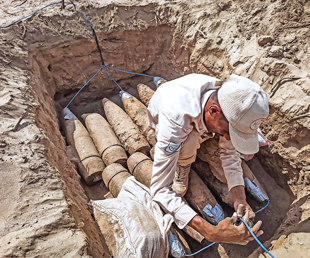
An operator in Yemen prepares to destroy explosive hazards. Courtesy of The HALO Trust.
Landmines, unexploded ordnance, and improvised explosive devices from the ongoing conflict continue to kill Yemeni civilians across the country, block access to critical infrastructure for basic services, and obstruct desperately needed humanitarian assistance. Republic of Yemen Government officials estimate that in recent years, Iran-backed Houthi forces have laid over one million landmines, making Yemen one of the most heavily mined countries in the world.
The United States has been the largest contributor to the United Nations Development Program’s engagement with the Yemen Executive Mine Action Center (YEMAC), having invested more than $61 million from FY97 to FY23. U.S. support provides survey and clearance, explosive ordnance risk education, survivors’ assistance, and capacity building for the YEMAC. With the United Nations Development Progreamme’s ending of support to YEMAC clearance teams in the summer of 2023, the United States has also led the way on funding the expanding capabilities of international nongovernmental organizations as they increase their capacity to operate in Yemen. This has greatly improved clearance standards and diversified the response mechanisms of assistance.
In FY23, the Department of State supported:
- Survey and clearance to help families safely return home and rebuild their lives and local economies.
- Explosive ordnance risk education for at risk communities.
- Medical and rehabilitative care, vocational training, and micro-grants for landmine survivors.
- Additional training and capacity building for the Aden-based Yemen Executive Mine Action Center. The Center continued to integrate an information management system, trained its staff on information management practices and procedures, helped develop national standards for non-technical surveys, and provided virtual training on how to conduct them.
|
Source |
FY97-20 |
FY21 |
FY22 |
FY23 |
TOTAL |
|
DOS NADR-CWD |
$44,355 |
$4,000 |
$4,875 |
$3,000 |
$56,230 |
|
DoD |
$4,846 |
$0 |
$0 |
$0 |
$4,846 |
|
Total |
$49,201 |
$4,000 |
$4,875 |
$3,000 |
$61,076 |
(dollars in thousands)
FY23 Yemen key performance metrics:
- 3,235,005 Sq m (799 acres) of land cleared
- 120 Explosive ordnance disposal call-outs
- 2,082 Landmines destroyed
- 48,039 Explosive remnants of war destroyed
- 946,592 Explosive ordnance risk education recipients
- 170 Survivor assistance recipients
- 29.31 Metric tons of unserviceable ammunition destroyed
- Implementing partners: Danish Refugee Council, Geneva International Centre for Humanitarian Demining, The HALO Trust, Marshall Legacy Institute, United Nations Development Programme
Other U.S. Support
With funding from the Department of Defense:
Morocco: With funding from the Department of Defense, U.S. Marine Forces Africa and the Utah National Guard continued explosive ordnance disposal Level 1 training with the Moroccan Royal Armed Forces.
Introduction
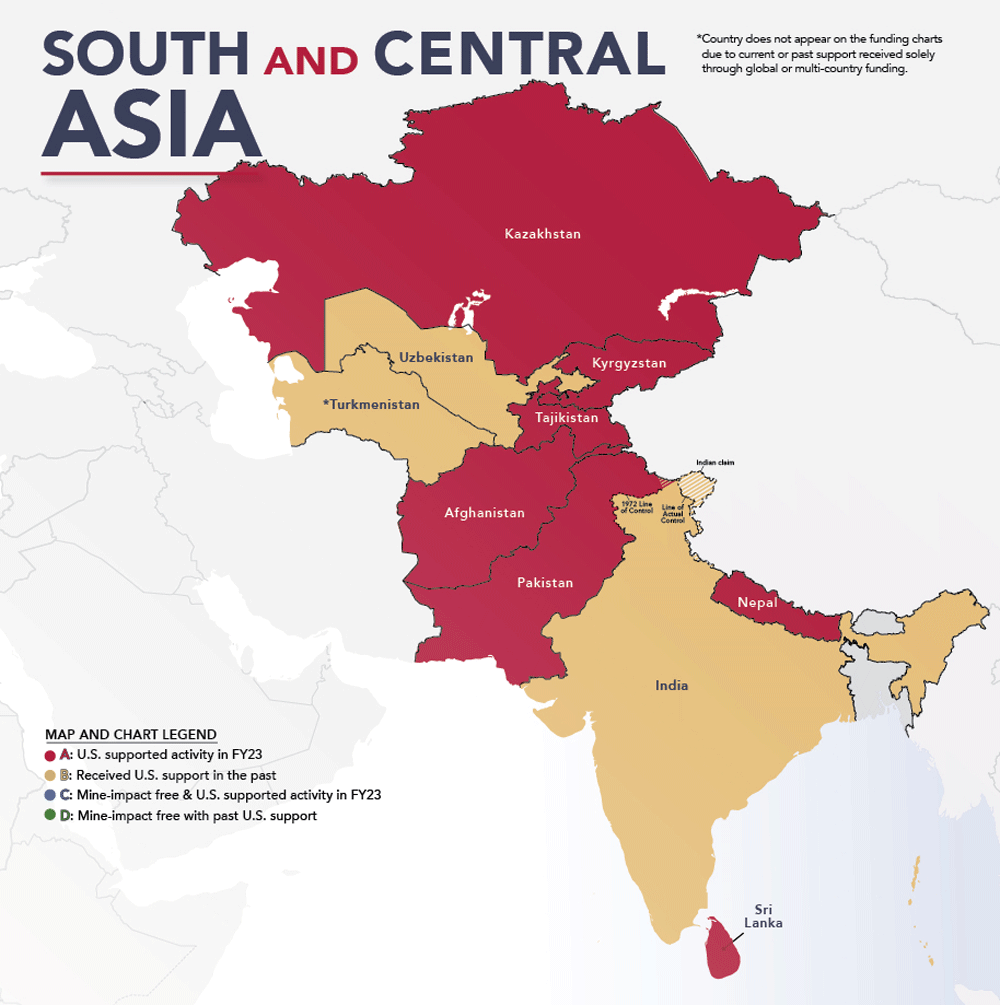
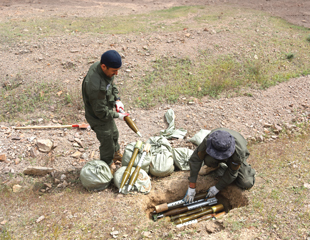
A weapons and ammunition destruction team in Tajikistan prepares for a demolition. Courtesy of Fondation Suisse de deminage.
With support from the United States, South and Central Asian countries are securing weapons and ammunition stockpiles, clearing landmines and unexploded ordnance that threaten civilians, promoting peace and security, and strengthening economic ties in the region, all of which advances the United States’ regional and global security priorities. Assistance provided by the United States addresses the most dangerous explosive hazards through immediate action while building partner nation capacity to manage future hazards over the long term, independent of American assistance. This approach is essential to enhancing regional stability, securing arms and ammunition that might otherwise fall into the wrong hands and fostering economic development.
Humanitarian mine action programs in Afghanistan continue despite the August 2021 takeover by the Taliban. Delivered through nongovernmental organizations, U.S. assistance is designed to directly benefit Afghan civilians who face the dangers of landmines and explosive remnants of war on a daily basis. International and national nongovernmental organizations with decades of experience clearing explosives support Afghans with one of the most capable mine action programs in the world. U.S. assistance not only removes landmines, improvised explosive devices, and unexploded and abandoned ordnance, it improves the lives and well-being of Afghans by providing employment and making land safe for farming, which provides a measure of economic and food security. Meanwhile, the Kyrgyz Republic and Kazakhstan are addressing the substantial risk from unsecured and deteriorating weapons and ammunition through stockpile reduction and disposal. Tajikistan is a regional leader in landmine clearance and explosive hazard remediation and is successfully managing its aging munitions stockpiles while clearing explosive hazards along its borders and within the central Rasht Valley region. Sri Lanka is dealing with extensive landmines, improvised explosive devices, and unexploded ordnance hazards that endanger civilians, inhibit livelihoods, and impede the resettlement of communities. Both Tajikistan and Sri Lanka have made significant progress in returning land and infrastructure to safe use and are nearing a future in which their people can thrive free from the threat of explosive hazards.
FY23 cumulative performance metrics in South and Central Asia (Metrics include total U.S. assistance across the region, not just key metrics from featured countries)
- 27,994,490 sq m (6,918 acres) of land cleared
- 11,394 Landmines destroyed
- 70,215 Survivor assistance recipients
- 99,436 Risk education recipients
- 38,054 Explosive remnants of war destroyed
- 1,463.3 Metric tons of ammunition destroyed
Allocation of $21.41 million allocated to South and Central Asia in FY23 by country (dollars in thousands)
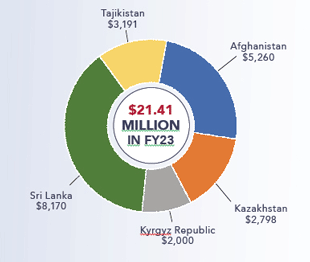
Top five countries funded in South and Central Asia FY93-FY23 (dollars in thousands)
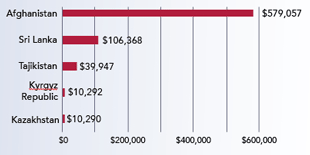
|
|
Country/Region |
FY93-20 |
FY21 |
FY22 |
FY23 |
Total |
|
A |
Afghanistan |
$538,274 |
$20,330 |
$15,193 |
$5,260 |
$579,057 |
|
B |
India |
$300 |
$0 |
$0 |
$0 |
$300 |
|
A |
Kazakhstan |
$3,383 |
$0 |
$4,109 |
$2,798 |
$10,290 |
|
A |
Kyrgyz Republic |
$3,792 |
$2,000 |
$2,500 |
$2,000 |
$10,292 |
|
A |
Nepal1 |
$6,936 |
$1,587 |
$0 |
$0 |
$8,523 |
|
A |
Pakistan1 |
$832 |
$0 |
$0 |
$0 |
$832 |
|
A |
Sri Lanka |
$81,365 |
$8,308 |
$8,525 |
$8,170 |
$106,368 |
|
A |
Tajikistan |
$29,172 |
$4,162 |
$3,422 |
$3,191 |
$39,947 |
|
B |
Uzbekistan |
$99 |
$0 |
$0 |
$0 |
$99 |
|
|
Regional |
$2,060 |
$0 |
$200 |
$0 |
$2,260 |
|
|
Total |
$666,213 |
$36,387 |
$33,949 |
$21,419 |
$757,968 |
- Countries with activities in FY23 that were solely funded through Global/Multi-Country
funding, but received direct funding in the past.
CHART LEGEND
A: U.S. supported activity in FY23
B: Received U.S. support in the past
C: Mine-impact free & U.S. supported activity in FY23
D: Mine-impact free with past U.S. support
Clearing the legacies of war in Sri Lanka: Making way for new development and opportunity
Article and images courtesy of MAG (Mines Advisory Group).
Sri Lanka experienced a civil war between the Liberation Tigers of Tamil Eelam and the Sri Lankan Armed forces that spanned more than three decades. Many landmines were used to defend borders and territories during the civil war, specifically in the northern and eastern provinces covering the cities and towns of Batticaloa, Kilinochchi, Mullaitivu, Mannar, Trincomalee, and Vavuniya.
The end of the civil war in 2009 triggered a massive demand to reoccupy villages and arable land that were polluted by explosives. Therefore, conducting systematic landmine and battle area clearance of the contaminated land became a top priority to begin housing development projects and provide other essential infrastructure such as schools, restored roads, irrigation systems for farmlands, hospitals, and industries to support the income of the civilians who have been displaced due to the war. While much progress has been made, there are still approximately 19.6 million square meters (4,834 acres) of confirmed hazardous areas in Sri Lanka as of September 2023.
Land Clearance Drives Development at Mankulam Base Hospital
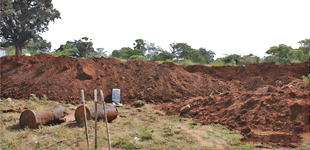
Construction at Mankulum Hospital.
The Mankulam Base Hospital was constructed in the 1980s but destroyed during the civil war. It was rebuilt in 2010 with the aid of the Sri Lankan government. However, in 2019, as a new building complex was being constructed on the same property, a landmine remaining from the war was discovered.
In December of that year, the national mine action center requested assistance from MAG (Mines Advisory Group) to clear the landmine. MAG assessed the area and began clearance on January 15, 2020. Ultimately ten mines and one unexploded rifle grenade were found on the land surrounding the hospital. Clearance was completed in March 2020.
As a result of the previous successful clearance, MAG was asked to clear another part of the hospital property to enable the safe construction of a water treatment plant and housing complex for hospital staff. Clearance began in April 2022, but construction is delayed due to economic circumstances.
“Construction workers were afraid to continue the project due to the landmines. Since MAG demined the land, contractors can work safely and without fear. Development of these facilities will be good not only for the current generation, but also future generations,” remarked Supashini, the Management Service Officer, Mankulam Hospital Base.
Land Release Improves Livelihoods
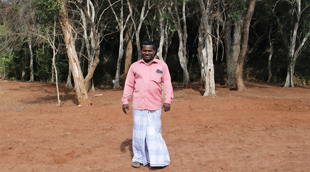
Sivasudhan on his land.
During the war in 2006, Sivasudhan, a farmer and his family were forced to flee from their home in Vavuniya. They ended up in the Chettikulam Internal Displacement Persons camp, managed by the Sri Lankan Army. In 2010, Sivasudhan and his family were able to return to their village of Navvi and rebuild their home with assistance from the Indian government’s Housing Project and the United Nations Development Program. To support his family, Sivasudhan grew food in his home garden, and sold firewood and honey.
More recently, he decided to cultivate land near his home that had once been used as a base for the Liberation Tigers of Eelam during the war. Even though the Sri Lankan Army had destroyed landmines found in this area, Sivasudhan still found several landmines while attempting to farm the land. He informed MAG deminers at a nearby demining site. MAG began to clear three acres of Sivasudhan’s land on August 23, 2022, and their work was completed on October 19, 2022. With the ability to farm this land, Sivasudhan is now looking forward to producing approximately 2,400 kg (over 5,000 pounds) of black gram beans and 900 kg (over 1,900 pounds) of sesame.
“The Civil War destroyed everything we had. Today we can carry on our work without fear since the land has been cleared,” remarked Sivasudhan. MAG’s work, which has been funded by the U.S. Government, is truly paying off.
Afghanistan
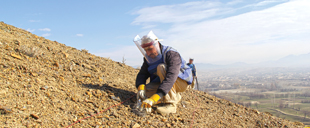
A deminer conducts battle area clearance in Afghanistan. Courtesy of The HALO Trust.
To improve the lives of the Afghan people, the United States provides conventional weapons destruction funding and support to help clear landmines, including abandoned improvised mines and unexploded ordnance left behind by the 1979 Soviet invasion and over 40 years of subsequent conflicts. According to the Mine Action Program of Afghanistan, more than 1,200 civilian casualties were caused by landmines, improvised mines, and other explosive hazards in 2022. Children comprised over 45 percent of those casualties. Unexploded ordnance and improvised explosive devices caused nearly 98 percent of these incidents. About two percent of civilian casualties are attributed to Soviet-era landmine contamination.
From FY93 to FY23, the United States invested more than $579 million for conventional weapons destruction programs in Afghanistan. This assistance continues to be delivered through nongovernmental organizations to directly benefit the Afghan people without assisting the Taliban.
In FY23, the Department of State supported:
- Clearing high-risk hazards such as minefields, unexploded ordnance, and abandoned improvised mines in Baghlan, Helmand, Kabul, Kandahar, Maidan Wardak, Nimroz, Nuristan, Paktika, Nangarhar and Panjsher Provinces.
- Clearance of high-risk hazard areas in northern Badakhshan Province.
- Surface and subsurface battle area clearance in central, western, and northern Afghanistan.
- Emergency callout response teams to identify, secure, and destroy cached munitions in central and eastern Afghanistan.
- The United Nations Mine Action Service/Mine Action Technical Cell to enhance oversight of information management and mine action programs.
- Explosive ordnance risk education for civilians in high-risk areas.
- Rehabilitation centers in Kabul, Farah, Paktya, and Paktika Provinces to provide physiotherapy, orthotics, and prosthetics services; and supported vocational rehabilitation and development training for landmine survivors and their immediate family members living with disabilities.
- Upgrades and renovations to enable persons with disabilities to access public facilities.
The Department of Defense Humanitarian Demining Research and Development Program partnered with The HALO Trust to evaluated fifteen technologies including the Minehound Lite mine detector; the Scorpion unexploded ordnance Detection System; the Storm Steep Slope Excavator; Minehound hand-held detectors for minimum-metal anti-tank mines; the Orbit Screener, which sifts mine-contaminated soil; the Wirehound and Groundhunter commercial handheld detectors; and a suite of mine action attachments for excavators and loaders. HALO also continues to evaluate three Raptor armored tractors with two attachments: the Rotary Mine Comb anti-tank mine clearance system and a powered harrow with clutter collection magnet. These technologies have been used in the clearance of over 34 million square-meters (8,476 acres) of land and over 57,000 mines and unexploded ordnance to date.
|
Source |
FY93-20 |
FY21 |
FY22 |
FY23 |
TOTAL |
|
DOS NADR-CWD |
$455,391 |
$20,000 |
$15,000 |
$5,000 |
$495,391 |
|
DOS Other |
$20,000 |
$0 |
$0 |
$0 |
$20,000 |
|
CDC |
$1,800 |
$0 |
$0 |
$0 |
$1,800 |
|
DoD |
$9,636 |
$330 |
$193 |
$260 |
$10,419 |
|
USAID |
$51,447 |
$0 |
$0 |
$0 |
$51,447 |
|
Total |
$538,274 |
$20,330 |
$15,193 |
$5,260 |
$579,057 |
(dollars in thousands)
FY23 Afghanistan key performance metrics:
- 26,174,136 Sq m (6,468 acres) of land cleared
- 3,112 Explosive ordnance disposal call-outs
- 1,491 Landmines destroyed
- 36,266 Explosive remnants of war destroyed
- 87,637 Explosive ordnance risk education recipients
- 70,173 Survivor assistance recipients
- 39 Metric tons of unserviceable ammunition destroyed
- 39 Personnel trained in stockpile management
- Implementing partners: Accessibility Organization for Afghan Disabled, Afghan Technical Consultants, Demining Agency for Afghanistan, Agency for Rehabilitation and Energy Conservation in Afghanistan, The HALO Trust, ITF Enhancing Human Security, Mine Clearance Planning Agency, Mine Detection Center, Norwegian People’s Aid, Organization for Mine Clearance and Afghanistan Rehabilitation, United Nations Mine Action Service
Kazakhstan
Kazakhstan faces substantial risk from poorly secured, aging, and deteriorating ammunition stockpiles that threaten civilian safety due to their proximity to populated areas. Kazakhstan suffered major explosions at munitions storage facilities in 2019 and again in 2021. From FY19 to FY23, the United States invested more than $10 million to help Kazakhstan segregate, secure, and destroy excess and unserviceable ammunition and landmines. This improved host-nation capacity to avert unplanned explosions at ammunition depots and prevent the illicit proliferation of munitions pilfered from national stockpiles.
In FY23 (with prior year funds), Department of State supported:
- Reducing the threats to human security posed by huge stockpiles of outdated, unserviceable, and unstable ammunition by creating national capacities for disposal in Arys, Kazakhstan.
- Helping the Kazakhstan Ministry of Defense prepare for the disposition of excess anti-tank landmines and construct a modular demilitarization facility to address other types of excess, obsolete, and degraded ammunition.
With funding from the Department of Defense, U.S. Central Command Provide training to the Bereg Explosive Hazards Center to build partner nation capacity towards a self-sustaining mine action program. Fourteen Kazakhstan Ministry of Defense personnel were trained on International Mine Action Standards Level 1 through Level 3 and Humanitarian Mine Action Casualty Care curriculums.
|
Source |
FY05-20 |
FY21 |
FY22 |
FY23 |
TOTAL |
|
DOS NADR-CWD |
$2,795 |
$0 |
$4,018 |
$2,500 |
$9,313 |
|
DoD |
$588 |
$0 |
$91 |
$298 |
$977 |
|
Total |
$3,383 |
$0 |
$4,109 |
$2,798 |
$10,290 |
(dollars in thousands)
FY23 Kazakhstan key performance metrics:
- Due to the nature of the assistance, metrics are not available for this fiscal year.
- Implementing partner: ITF Enhancing Human Security
Kyrgyz Republic
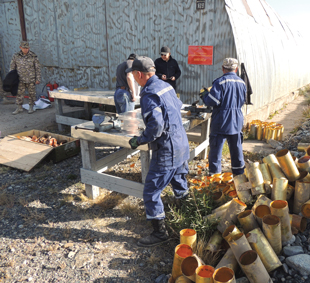
Expired artillery is destroyed in the Kyrgyz Republic. Courtesy of ITF Enhancing Human Security.
The Kyrgyz Republic faces substantial risk from unsecured, deteriorating arms and ammunition storage facilities that threaten civilian safety and are at risk of cross border proliferation. From FY09 to FY23, the United States invested more than $10 million to help the Kyrgyz Republic refurbish its existing explosives storage sites and segregate, secure, and destroy excess and unserviceable munitions. This assistance has improved the capacity to prevent unplanned explosions at munitions sites that have the potential to injure and kill adjoining civilian populations. It will also reduce the risk of illicit proliferation of munitions from national stockpiles.
In FY23, the Department of State supported:
- The Kyrgyz Republic Ministry of Defense efforts to dispose of expired artillery ammunition and outdated or obsolete conventional weapons, renovate artillery ammunition storehouses, and develop proper national munitions stockpile management capacity.
- The Kyrgyz Republic Border Service of the State Committee for National Security undertook efforts to dispose of obsolete explosive ordnance and improve physical security and stockpile management of small arms, light weapons, and conventional ammunition. Additionally, conventional weapons destruction assistance developed an integrated approach to combat the illicit trafficking of weapons, ammunition, and explosives, as well as supported canine (K9) detection training.
|
Source |
FY09-20 |
FY21 |
FY22 |
FY23 |
TOTAL |
|
DOS NADR-CWD |
$3,785 |
$2,000 |
$2,500 |
$2,000 |
$10,285 |
|
DoD |
$7 |
$0 |
$0 |
$0 |
$7 |
|
Total |
$3,792 |
$2,000 |
$2,500 |
$2,000 |
$10,292 |
(dollars in thousands)
FY23 Kyrgyz Republic key performance metrics:
- 162.86 Metric tons of unserviceable ammunition destroyed
- 7 Armories Built or rehabilitated
- Implementing partners: ITF Enhancing Human Security, Organization for Security and Co-Operation in Europe
Sri Lanka
In the 15 years following the end of Sri Lanka’s civil war, demining and explosive ordnance removal programs have cleared hundreds of acres of land and allowed for civilians to return to live and work safely in their communities. Remaining explosive contamination, particularly in the north and east of the country, continues to threaten the safety of men, women, and children. Clearing the continuing presence of mines, unexploded ordnance, and improvised explosives is a top priority as Sri Lanka approaches its goal to be mine-impact free by 2027. According to the Sri Lanka National Mine Action Center, as of September 2023, approximately 19.6 million square meters (4,843 acres) of confirmed hazardous areas remained to be cleared.
From FY95 to FY23, the United States invested more than $106 million to survey and clear explosive hazards, provide explosive ordnance risk education to prevent further injuries, support training in physical security and stockpile management, and provide additional capacity building measures. U.S. support remains critical to meeting Sri Lanka’s mine-impact free goals by 2027.
In FY23, the Department of State supported:
- Survey, clearance, and explosive ordnance risk education in Jaffna, Kilinochchi, Mannar, Mullaitivu, Trincomalee, and Vavuniya Districts.
- The Sri Lankan Police Training Brigade to better secure and account for its stocks of arms and ammunition by constructing new storage facilities and upgrading existing ones.
- Armory storekeeper and management training to improve Sri Lanka’s capacity to safely handle and manage its national stockpiles.
- The implementation of the National Mine Action Center’s Completion Strategy to achieve a mine-impact free Sri Lanka by 2027.
- Skill development training to help transition demining staff into other sectors as Sri Lanka nears completion of mine clearance efforts.
The Department of Defense Humanitarian Demining Research and Development Program partnered with The HALO Trust and MAG (Mines Advisory Group) to continue evaluating the Rex light-weight armored excavator; the Improved Backhoe system and rake attachments; the Light Soil Sifter, a soil-sifting excavator attachment; and HSTAMIDS detectors. Additionally, the program deployed the Kompaq Screening System in September 2023 and will begin its evaluation in fiscal year 2024. The equipment will provide area preparation, area reduction, and mine-clearance capabilities to clear villages and agricultural land. Program technologies cleared over 34,000 mines and unexploded ordnance from approximately 5 million square-meters of land (1,236 acres) to date.
As part of a multi-country programs, USAID’s Leahy War Victims Fund supported Results for Development and the World Health Organization to integrate and strengthen rehabilitation services in existing healthcare systems.
|
Source |
FY95-20 |
FY21 |
FY22 |
FY23 |
TOTAL |
|
DOS NADR-CWD |
$65,341 |
$8,000 |
$8,500 |
$7,000 |
$88,841 |
|
DOS Other |
$122 |
$0 |
$0 |
$0 |
$122 |
|
CDC |
$175 |
$0 |
$0 |
$0 |
$175 |
|
DoD |
$4,502 |
$308 |
$25 |
$1,170 |
$6,005 |
|
USAID |
$11,255 |
$0 |
$0 |
$0 |
$11,225 |
|
Total |
$81,365 |
$8,308 |
$8,525 |
$8,170 |
$106,368 |
(dollars in thousands)
FY23 Sri Lanka key performance metrics:
- 1,608,412 Sq m (397 acres) of land cleared
- 9,490 Landmines destroyed
- 1,650 Explosive remnants of war destroyed
- 11,523 Explosive ordnance risk education recipients
- 899.02 Metric tons of unserviceable ammunition destroyed
- 21 improvised explosive devices or components destroyed
- 278 Personnel trained in stockpile management
- 6 Armories built or rehabilitated
- Implementing partners: Delvon Assistance for Social Harmony, The HALO Trust, MAG (Mines Advisory Group), Results for Development, Skavita Humanitarian Assistance and Relief Project, World Health Organization
Tajikistan
Tajikistan inherited an enormous stockpile of aging munitions following the collapse of the Soviet Union, including large-caliber ordnance and other explosives. Due to its porous borders with Afghanistan, poorly secured small arms, light weapons, and ammunition present a real threat to national and regional security. Tajikistan also has extensive landmine and cluster munitions contamination along its southern and western borders that stems from its civil war in the 1990s and earlier Soviet attempts to prevent border crossings by Afghan militants and narcotics traffickers. During its civil war (1992–1997), Tajikistan’s Central Rasht Valley region was heavily littered with explosive hazards that impede the socioeconomic development of this fertile region. Explosive hazards limit access to valuable agricultural land and endanger border crossings, farming, wood gathering, and livestock grazing.
From FY04 to FY23, the United States invested more than $39 million to clear explosive hazards, destroy excess and aging munitions, and provide survivors’ assistance. The United States also provided physical security and stockpile management training, as well as national capacity building for the Tajikistan National Mine Action Center.
In FY23, the Department of State supported:
- Multiple demining teams, including one to respond to explosive ordnance disposal call-outs and destroy stockpiled munitions, as well as two mixed-gender clearance teams, three manual demining teams, and four non-technical survey teams that worked along the southern Tajik-Afghan border.
- The Tajikistan National Mine Action Center’s capacity by providing training on demining, program management, project development, and quality-assurance.
- The Ministry of Defense to strengthen capacity to destroy explosive hazards identified by communities.
- A regional workshop to share lessons learned across Central Asian countries and to foster closer cooperation on security and defense issues.
- Several regional training courses to build national capacity in explosive ordnance disposal and munitions stockpile management.
With funding from the Department of Defense, U.S. Central Command conducted three International Mine Action Standards trainings to the Regional Explosive Hazards Training Center, resulting in 19 Tajikistan Ministry of Defense instructors completing humanitarian mine action International Mine Action Standards Level 3 and Humanitarian Mine Action Casualty Care curriculums.
As part of its multi-regional programs, USAID’s Leahy War Victims Fund supported the World Health Organization and Momentum Wheels for Humanity to strengthen the health rehabilitation sector and integrate rehabilitation services in existing healthcare.
|
Source |
FY04-20 |
FY21 |
FY22 |
FY23 |
TOTAL |
|
DOS NADR-CWD |
$22,983 |
$3,300 |
$3,310 |
$2,500 |
$32,093 |
|
DoD |
$3,309 |
$862 |
$112 |
$691 |
$4,974 |
|
USAID |
$2,880 |
$0 |
$0 |
$0 |
$2,880 |
|
Total |
$29,172 |
$4,162 |
$3,422 |
$3,191 |
$39,947 |
(dollars in thousands)
FY23 Tajikistan key performance metrics:
- 211,942 Sq m (52 acres) of land cleared
- 413 Landmines destroyed
- 138 Explosive remnants of war destroyed
- 351 Explosive ordnance risk education recipients
- 42 Survivor assistance recipients
- 1.05 Metric ton of unserviceable ammunition destroyed
- Implementing partners: International Committee of the Red Cross, Fondation suisse de déminage, Momentum Wheels for Humanity, Norwegian People’s Aid, Organization for Security and Co-operation in Europe, Tajikistan National Mine Action Center, World Health Organization
Other U.S. Support
With funding from USAID’s Leahy War Victims Fund:
- Nepal: Humanity and Inclusion worked to establish a sustainable, integrated, public-private rehabilitation system to improve the mobility and functional independence of survivors of conflict and others in need of rehabilitation services. As part of a multi-regional program conducted with prior year funds, USAID continued to help the World Health Organization to integrate and strengthen rehabilitation services in existing healthcare systems.
- Pakistan: As part of a multi-regional program, Johns Hopkins University-Bloomberg School of Public Health continued to develop health systems that are responsive to needs for rehabilitation across the patient lifespan, and the World Health Organization to integrate and strengthen rehabilitation services in existing healthcare systems.
Introduction
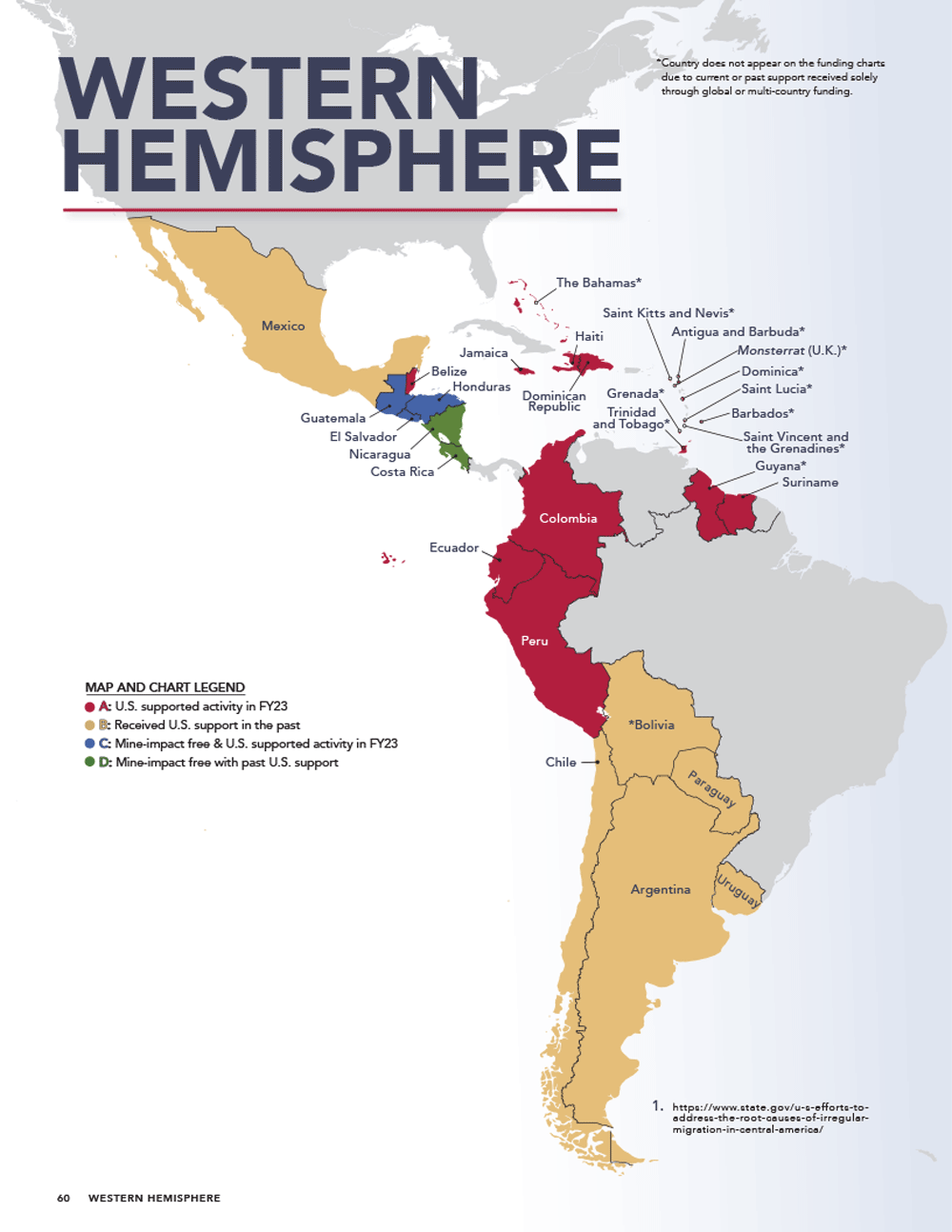
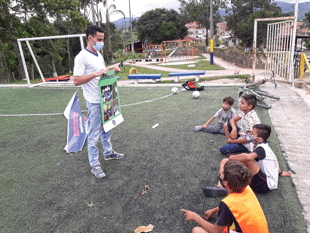
Spirit of Soccer uses sports to conduct explosive ordnance risk education in Colombia. Courtesy of Spirit of Soccer.
In Latin America, the United States funds physical security and stockpile management programs in Ecuador, El Salvador, Guatemala, Honduras, Peru, and the Caribbean region. This work improves the security and management of munitions stockpiles, disrupts the diversion and illicit trafficking of small arms and light weapons, and reduces the risk of catastrophic unplanned explosions at munition storage sites. These programs strengthen civilian security, make it more difficult for drug traffickers, criminal gangs, and terrorists to obtain weapons from poorly secured stockpiles, and bolster the integrity of the United States’ southern border. U.S. efforts to reduce the availability of illicit weapons across the hemisphere support Pillar IV of the U.S. Strategy for Addressing the Root Causes of Migration in Central America, which focuses on countering and preventing violence, extortion, and other crimes perpetrated by criminal gangs, trafficking networks, and other organized criminal organizations.
In addition to addressing the illicit proliferation of weapons, the United States provides humanitarian demining assistance to Colombia, which remains the country in the Americas most heavily affected by landmines. Explosive hazards continue to threaten the livelihood of Colombians, making it difficult for families to safely return to their homes and disrupting the restoration of local economies. Since 2016, demining operations have expanded into previously inaccessible locations, thanks to the Government of Colombia’s peace accord with the Revolutionary Armed Forces of Colombia (FARC). The Government of Colombia, with the assistance of the United States and other international donors, continues to clear Colombia’s remaining explosive hazards and return agricultural land to productive use.
FY23 cumulative performance metrics in the Western Hemisphere (Metrics include total U.S. assistance across the region, not just key metrics from featured countries)
- 176,126 sq m (44 acres) of land cleared
- 19 explosive remnants of war destroyed
- 7,225 Small arms/light weapons destroyed
- 63,915 Risk education recipients
- 52 Explosive ordnance disposal call-outs
- 194.34 Metric tons of ammunition destroyed
Allocation of $40.69 million allocated to the Western Hemisphere in FY23 by country (dollars in thousands)
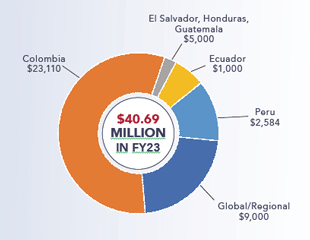
Top Five Countries Funded in the Western Hemisphere FY93-FY23 (dollars in thousands)
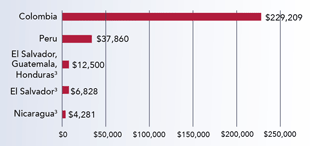
|
|
COUNTRY/Region |
FY93-20 |
FY21 |
FY22 |
FY23 |
FY93-23 |
|
B |
Argentina |
$579 |
$0 |
$0 |
$0 |
$579 |
|
A |
Belize1 |
$300 |
$0 |
$0 |
$0 |
$300 |
|
A |
Caribbean |
$1,850 |
$0 |
$0 |
$0 |
$1,850 |
|
B |
Chile |
$3,450 |
$0 |
$0 |
$0 |
$3,450 |
|
A |
Colombia |
$159,975 |
$21,537 |
$24,587 |
$23,110 |
$229,209 |
|
A |
Dominican |
$500 |
$0 |
$0 |
$0 |
$500 |
|
A |
Ecuador |
$11,316 |
$3,207 |
$1,591 |
$1,000 |
$17,114 |
|
C |
El Salvador2 |
$6,828 |
$0 |
$0 |
$0 |
$6,828 |
|
C |
El Salvador, Guatemala, |
$2,500 |
$3,000 |
$2,000 |
$5,000 |
$12,500 |
|
C |
Guatemala2 |
$900 |
$0 |
$0 |
$0 |
$900 |
|
A |
Haiti1 |
$3,500 |
$0 |
$0 |
$0 |
$3,500 |
|
C |
Honduras2 |
$1,464 |
$0 |
$0 |
$0 |
$1,464 |
|
B |
Mexico |
$775 |
$0 |
$0 |
$0 |
$775 |
|
D |
Nicaragua |
$4,281 |
$0 |
$0 |
$0 |
$4,281 |
|
B |
Paraguay |
$200 |
$0 |
$895 |
$0 |
1,095 |
|
A |
Peru |
$31,135 |
$2,515 |
$1,626 |
$2,584 |
$37,860 |
|
A |
Suriname1 |
$390 |
$0 |
$0 |
$0 |
$390 |
|
B |
Uruguay |
$200 |
$0 |
$0 |
$0 |
$200 |
|
|
Regional3 |
$0 |
$0 |
$1,500 |
$9,000 |
$10,500 |
|
|
Total |
$230,143 |
$30,259 |
$32,199 |
$40,694 |
$333,295 |
CHART LEGEND
A: U.S. supported activity in FY23
B: Received U.S. support in the past
C: Mine-impact free & U.S. supported activity in FY23
D: Mine-impact free with past U.S. support
- Countries and territories receiving funding as part of the Caribbean Firearms Roadmap include Antiqua and Barbuda, The Bahamas, Barbados, Belize, Dominica, Dominican Republic, Grenada, Guyana, Haiti, Jamaica, Monserrat, Saint Lucia, Saint Kitts and Nevis, Saint Vincent and the Grenadines, Suriname, and Trinidad and Tobago.
- El Salvador, Honduras, Guatemala began receiving regional funding in FY19.
- Regional funding for FY22 includes $1.5 million, plus $2 million allocated in the
El Salvador, Guatemala, Honduras funding line. - For purposes of this document, countries denoted as mine impact free are countries that are free from the dangers of landmines to the general population but not necessarily free from all land mines.
Clearing improvised explosive devices in Colombia: Planting the seed for economic security
Article and images courtesy of Humanity & Inclusion.
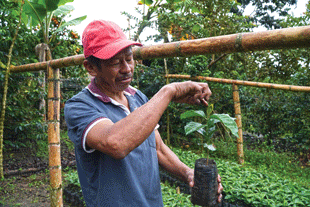
Justiniano inspects a coffee plant seedling.
In 2004, Justiniano, his wife Rosalba, and their three daughters arrived in the village of La Meseta. They came with a dream: to live on a farm and create a better future for their children.
Unfortunately, local militants had different plans. Just a few years after the family moved in, combatants used the farm as a transit point and campsite. They littered the area with “tatucos”—improvised devices made of cylinders filled with explosives. From that moment, Justiniano stopped cultivating the family’s land and fenced it off.
Colombia is one of the planet’s most biodiverse countries and boasts the perfect climate for coffee growers. In fact, where Justiniano’s family lives in the Cauca region, the soil is perfect for not only coffee, but also sugar cane, corn, plantain, cassava, and vegetables. What’s more, the agricultural tradition of the Nasa indigenous community, which includes Justiniano’s family, encourages families to contribute to the production of healthy food in a way that is resilient to the climate and in harmony with the environment. This is vital to the communities’ food security and nutrition.
Colombia also happens to be one of the most contaminated countries in the world in terms of explosive hazards. The use of landmines and explosive ordnance during decades of armed conflict have forced many families to abandon their traditions and economic activities. The presence of explosive devices made it impossible to plant or walk across their land, posing a physical threat and a psychological impact.
The Colombians most affected by these threats live in rural areas. Thanks to the support of the U.S. Department of State’s Office of Weapons Removal and Abatement, Humanity & Inclusion’s Colombian demining teams work in villages, national parks, along roads, even perched on mountainsides to remove the threat of explosive devices. Their teams conduct demining in seven municipalities in Cauca, successfully releasing the land in three of them so far: Puracé in 2021, Inzá in 2022, and Santander de Quilichao in 2023.
As part of Humanity & Inclusion demining operations in Inzá, teams spent five months inspecting and clearing Justiniano’s farm. They released more than an acre of land, allowing Justiniano’s family to cultivate it once again.
“Access to our land means that my family will now be able to get ahead,” Justiniano says, looking out at the mountains from land that once was a minefield. “Even if it is not for my wife and me, our work will guarantee the welfare of our daughters.”
On the farm, a variety of plants that make the soil healthy and productive, including cassava, plantain, and vegetables, are growing again.
“I am already preparing the land to plant my coffee—some 5,000 plants. With these crops we’ll be able to make a living, to feed ourselves,” he says.
The family has grown since 2004, with Justiniano and Rosalba welcoming several grandchildren. Thanks to explosive hazard clearance, their grandchildren can now play and run about the farm without the risk of harm. Justinianio and Rosalba’s daughters will also be able to uphold the farming traditions of their community. Like their newly planted crops, their hope and economic security are taking root again.
The Caribbean Region
Armed violence in the Caribbean continues to threaten civilian security and regional stability. The region’s unique geography makes it a key transit point for illicitly trafficked arms, narcotics, and other goods that flow between the United States and Central and South America. The region accounts for approximately 23 percent of all globally recorded homicides despite being home to less than 1 percent of the world’s population.
Under the auspices of the Caribbean Basin Security Initiative, 16 Caribbean states and U.S. stakeholders developed a set of priority actions to address the illicit proliferation of firearms and ammunition called the Caribbean Firearms Roadmap. The United States supports implementation of the roadmap.
In FY23 (with prior year funds), the State Department supported:
- The drafting and implementation by Caribbean states of individual National Action Plans. These plans will map out States national priorities, plans, and specific timelines for implementing the Caribbean Firearms Roadmap and will prioritize bolstering law enforcement capacity to combat illicit firearms and ammunition trafficking as well as decreasing the risk of diversion of firearms and ammunition from government owned arsenals.
- Training programs to bolster capabilities in detecting and preventing firearms and ammunition trafficking.
- Physical security assessments of vulnerable conventional weapons stockpiles.
|
Source |
FY19-20 |
FY21 |
FY22 |
FY23 |
TOTAL |
|
DOS NADR-CWD |
$750 |
$0 |
$0 |
$0 |
$750 |
|
DOS-Other |
$1,100 |
$0 |
$0 |
$0 |
$1,100 |
|
Total |
$1,850 |
$0 |
$0 |
$0 |
$1,850 |
(dollars in thousands)
FY23 Caribbean region key performance metrics:
- 42 Personnel trained in stockpile management
- Implementing partner: United Nations Regional Center for Peace, Disarmament,
and Development in Latin America and the Caribbean
Colombia
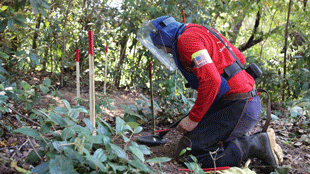
In Colombia, a deminer locates a suspected landmine and marks the area. Courtesy of The HALO Trust.
Following its 2016 Peace Accord with the Revolutionary Armed Forces of Colombia, the Government of Colombia has committed significant resources to address the widespread landmine and improvised explosive device contamination throughout the country. This includes civilian support and coordination provided by the national mine action authority, Descontamina, under the auspices of the Office of the High Commissioner for Peace, and more than 5,200 humanitarian deminers from its military.
The Office of the High Commissioner for Peace reports that Colombia has suffered more than 12,300 recorded mine incidents since 1990, the highest number in the Western Hemisphere. Its six most heavily affected departments are Antioquia, Caquetá, Cauca, Meta, Nariño, and Norte de Santander. In many areas, landmines and improvised explosive devices have physically displaced communities and reduced their access to agricultural land, which is their primary source of income. These disruptions are amplified for indigenous communities, which also depend on their protected ancestral lands for subsistence farming and spiritual practices. The return of cleared land in Colombia allows farmers and indigenous communities to restart agricultural production, increases the availability and diversity of sustainable food sources, and contributes to both economic and cultural stability.
Since FY01, the United States has invested more than $229 million to support Colombia’s mine action sector. In addition to helping Colombia build its substantial national demining capacity, this assistance facilitates the survey of priority municipalities and clearance of high-impact minefields, with an increased focus on areas where such efforts coincide with planned development and stabilization projects.
In FY23, the Department of State supported clearance operations in several municipalities across Colombia’s most heavily affected departments as well as explosive ordnance risk education for children and communities through sport-based activities. The Department also supported the external monitoring mission that provided quality control and quality assurance to ensure all demining operations are completed safely, as required by international and Colombian national standards.
With funding from the Department of Defense:
In support of U.S. Southern Command, the Humanitarian Demining Research and Development Program deployed the Little Storm, Bearcat, and Rambo systems to the Colombian Marine Forces.
- With previous year funding, U.S. Southern Command delivered the battery chargers and spare batteries for 694 APX 5000 VHF MHZ Model 3.5 portable radios procured improving the Colombian military’s effectiveness and communications during humanitarian demining operations.
- USAID’s the Leahy War Victims Fund supported the International Organization for Migration to implement guidelines for rehabilitative services. The fund also supported the Arcangeles Foundation in the development of inclusive sport activities and physical rehabilitation services in conflict affected communities. As part of multi-regional programs, the fund also supported the World Health Organization to integrate and strength rehabilitation services in existing healthcare systems.
| Source |
FY01-20 |
FY21 |
FY22 |
FY23 |
TOTAL |
|
DOS NADR-CWD |
$122,599 |
$21,000 |
$21,000 |
$21,000 |
$185,599 |
|
CDC |
$450 |
$0 |
$0 |
$0 |
$450 |
|
DoD |
$12,559 |
$37 |
$1,087 |
$110 |
$13,793 |
|
USAID |
$24,367 |
$500 |
$2,500 |
$2,000 |
$29,367 |
|
Total |
$159,975 |
$21,537 |
$24,587 |
$23,110 |
$229,209 |
(dollars in thousands)
FY23 Colombia key performance metrics:
- 176,126 Sq m (44 acres) of land cleared
- 52 Explosive ordnance disposal call-outs
- 36 Landmines destroyed
- 19 Explosive remnants of war destroyed
- 6 improvised explosive devices or components destroyed
- 63,915 Explosive ordnance risk education recipients
Implementing partners: Arcangeles Foundation, Colombia Campaign Against Landmines, Humanitarian Disarmament and Peacebuilding, Geneva International Centre for Humanitarian Demining, Humanity and Inclusion, The HALO Trust, International Organization for Migration, Organization of American States, Spirit of Soccer, Fondation suisse de déminage, World Health Organization
Ecuador
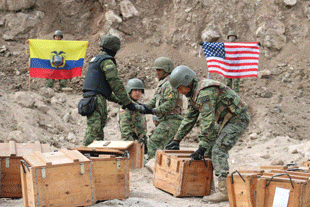
The United States and Ecuadorian armed forces worked together to destroy eight tons of obsolete munitions. Courtesy of MAG (Mines Advisory Group).
Since a border conflict with Peru in 1995, Ecuador has invested significant resources to responsibly store and manage its national munitions stockpiles. In February 2020, the Department of State launched a new conventional weapons destruction program to support Ecuador’s ongoing efforts.
From FY01 to FY23, the United States invested more than $17 million to support conventional weapons destruction activities in Ecuador. In FY23, U.S. assistance continued to improve management and security at priority munitions depots, facilitate the destruction of obsolete ordnance, and assure that the explosive ordnance disposal training curriculum for Ecuador’s armed forces met international standards.
In FY23, Department of State supported:
- Destruction of obsolete ordnance and provided ammunition management courses to Ecuador’s armed forces.
- Prioritizing the destruction of MANPADS in coordination with the Ecuadorian Army and Air Force, which diminishes the risk of illicit trafficking of such weapons, promotes regional security, and safeguards global aviation.
- Physical security and infrastructure upgrades to priority weapons facilities to better protect and safely manage stored munitions.
|
Source |
FY01-20 |
FY20 |
FY22 |
FY23 |
TOTAL |
|
DOS NADR-CWD |
$7,525 |
$2,000 |
$1,500 |
$1,000 |
$12,025 |
|
DoD |
$3,791 |
$1,207 |
$91 |
$0 |
$5,089 |
|
Total |
$11,316 |
$3,207 |
$1,591 |
$1,000 |
$17,114 |
(dollars in thousands)
FY23 Ecuador key performance metrics:
- 5,304 Small arms and light weapons destroyed
- 21.87 Metric ton of unserviceable ammunition destroyed
- 139 Personnel trained in stockpile management
- 14 Armories built or rehabilitated
- Implementing partner: MAG (Mines Advisory Group)
El Salvador, Guatemala, Honduras
Central America’s porous borders and illegal armed groups facilitate and sustain the illicit proliferation of small arms and light weapons that threaten civilians and host nation security forces. Additionally, the significant stockpiles of confiscated weapons held by the region’s governments that have neither been secured or properly disposed of remains a major proliferation concern. Many of the weapons confiscated from criminal organizations and other non-state armed groups are military-grade and highly vulnerable to theft.
The Department of State consolidated its El Salvador, Guatemala, and Honduras projects into one regional project in FY19. From FY19 to FY23, the United States invested more than $12 million to support conventional weapons destruction in these three countries. These projects are designed to better secure vulnerable depots through physical security and stockpile management enhancements and provide specialized training to develop national capacity within the region’s military and national police forces. Some confiscated firearms and obsolete ammunition and ordnance were also destroyed, in coordination with local authorities. These objectives contribute to Pillar IV of the 2021 White House Strategy to Address the Root Causes of Migration in Central America, which is to “counter and prevent violence, extortion, and other crimes perpetrated by criminal gangs, trafficking networks, and other organized criminal organizations.”
In FY23, the Department of State supported:
- The destruction of obsolete munitions.
- Continued strengthening of national military and police physical security and stockpile management capacities by providing training for security forces personnel, installing physical upgrades to weapons storage facilities, and reducing easy access to government weapons.
As part of multi-regional programs, USAID’s Leahy War Victims Fund supported the World Health Organization to integrate and strength rehabilitation services in existing healthcare systems in El Salvador, Guatemala, and Honduras.
|
Source |
FY19-20 |
FY21 |
FY22 |
FY23 |
TOTAL |
|
DOS NADR-CWD |
$2,500 |
$3,000 |
$2,000 |
$5,000 |
$12,500 |
|
Total |
$2,500 |
$3,000 |
$2,000 |
$5,000 |
$12,500 |
(dollars in thousands)
FY23 El Salvador, Guatemala, Honduras key performance metrics:
- 1,921 Small arms and light weapons destroyed
- 2.15 Metric ton of unserviceable ammunition destroyed
- 59 Personnel trained in stockpile management
- 7 Armories built or rehabilitated
- Implementing partners: The HALO Trust, World Health Organization
Peru
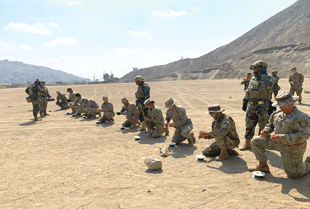
U.S. Southern Command conducts an explosive ordnance disposal train-the-trainer course in Peru. Courtesy of U.S. Department of Defense.
Peru retains a significant amount of excess and obsolete weapons and ammunition stemming from a border conflict with Ecuador in 1995. U.S. conventional weapons destruction programs address the vulnerabilities of weapons stockpiles located in both remote and urban areas by providing physical security upgrades to depots and facilitating training for security personnel to ensure the safe management of these aging munitions. Better management and the eventual destruction of excess munitions is required for Peru to reduce the risk of illicit proliferation and unplanned depot explosions.
From FY99 to FY23, the United States contributed more than $37 million to first support humanitarian mine action activities and, more recently, to implement a small arms and light weapons disposal project. Previous assistance to Peru’s mine action sector strengthened its national mine action authority and ensured the country was sufficiently equipped to reduce its landmine contamination on its own. Currently, Department of State assistance helps mitigate the risk of unplanned explosions of obsolete ordnance and strengthens Peru’s capacity to efficiently manage its munitions stockpiles.
In FY23, the Department of State supported:
- Physical security and stockpile management capacity building to address excess and obsolete munitions at priority depots through the destruction of weapons and ammunition.
- Expansion of physical security and stockpile management assistance with the Peruvian National Superintendence for the Control of Security Services, Arms, Ammunition and Explosives for Civilian Use, as well as expanded activities with both the Peruvian Navy and Air Force. Previous activities with the Army continued.
- Training and high-level seminars to socialize and institutionalize the importance of conventional weapons destruction programs at ministerial levels. These efforts emphasize physical security and stockpile management activities as vital to prevent unplanned explosions and theft of small arms and light weapons out of Peruvian stockpiles.
With funding from the Department of Defense, U.S. Southern Command executed, with assistance from explosive ordnance disposal instructors from the Wisconsin, New Jersey, Massachusetts, Nebraska, Colorado, and California Air National Guards, as well as explosive ordnance disposal instructors from the Civil Engineer Squadrons based in Andrews Air Force Base and Nellis Andrews Air Force Base completed Phases 1, 2, & 3 of explosive ordnance disposal Level 1 training and equipping, graduating 60 Peruvian Military members ready for the follow-on training during FY24.
|
Source |
FY99-20 |
FY21 |
FY22 |
FY23 |
TOTAL |
|
DOS NADR-CWD |
$18,006 |
$1,000 |
$1,605 |
$2,000 |
$22,611 |
|
DoD |
$12,129 |
$1,515 |
$21 |
$584 |
$14,249 |
|
USAID |
$1,000 |
$0 |
$0 |
$0 |
$1,000 |
|
Total |
$31,135 |
$2,515 |
$1,626 |
$2,584 |
$37,860 |
(dollars in thousands)
FY23 Peru key performance metrics:
- 170.32 metric tons of unserviceable ammunition destroyed
- 30 personnel trained in stockpile management
- Implementing partner: MAG (Mines Advisory Group)
